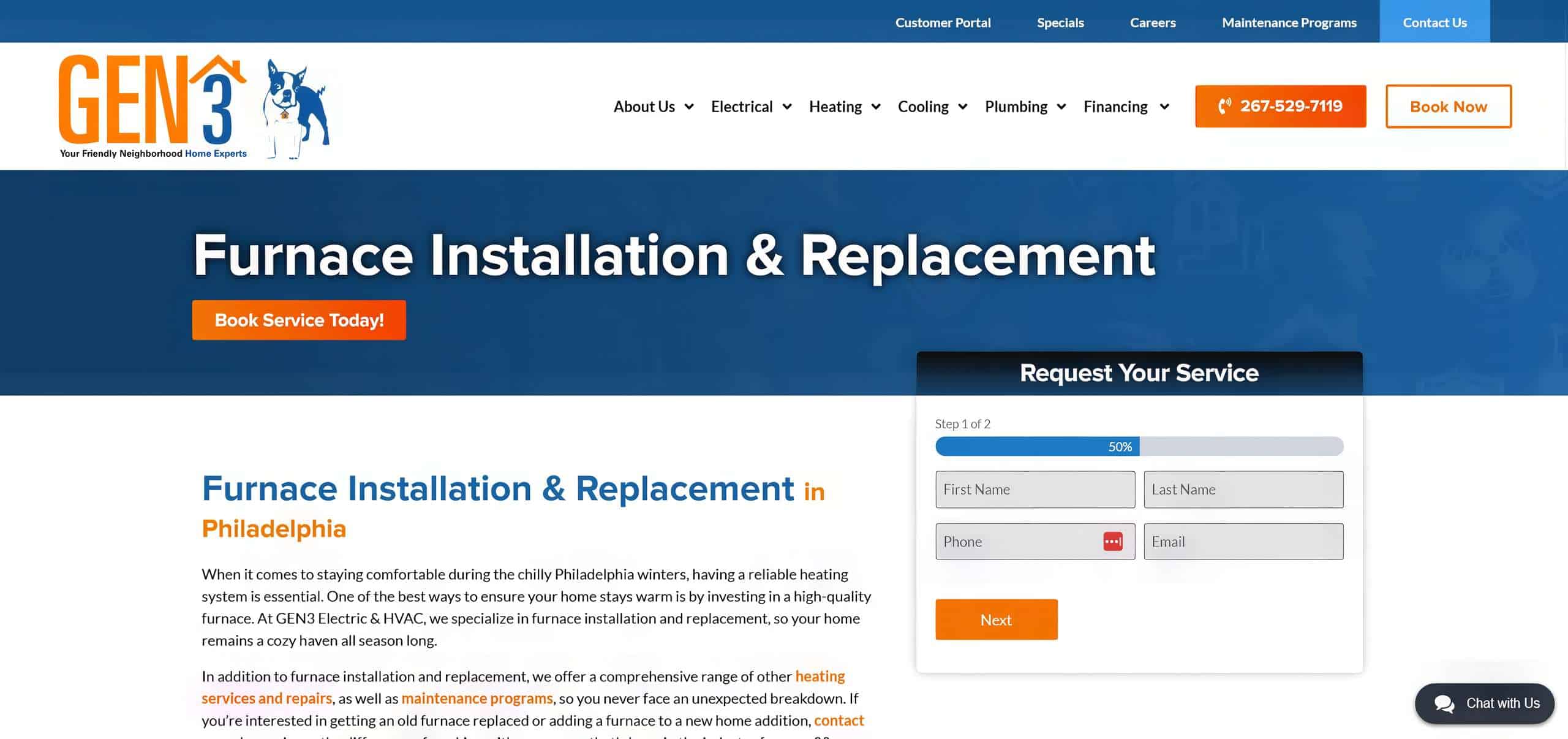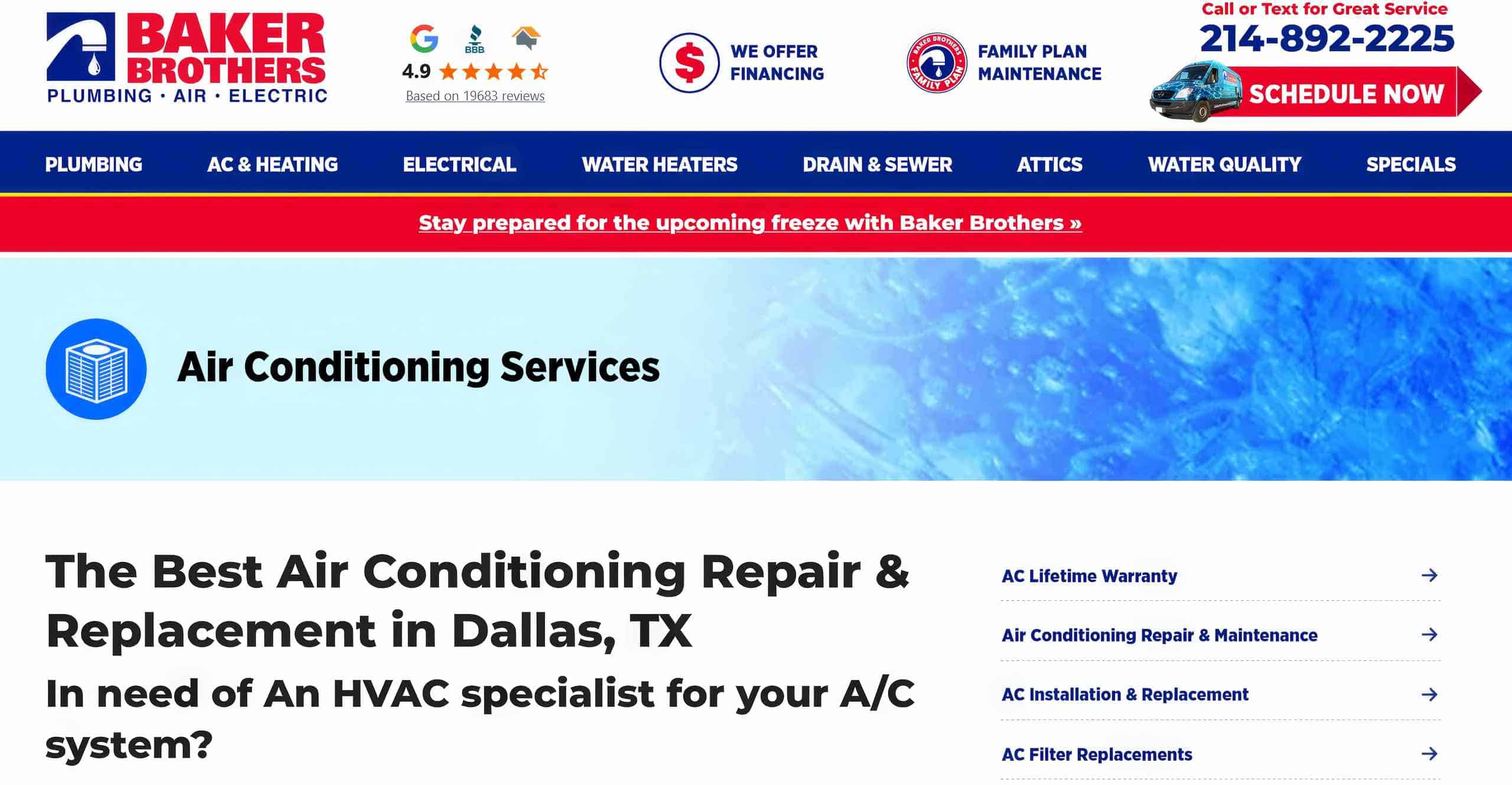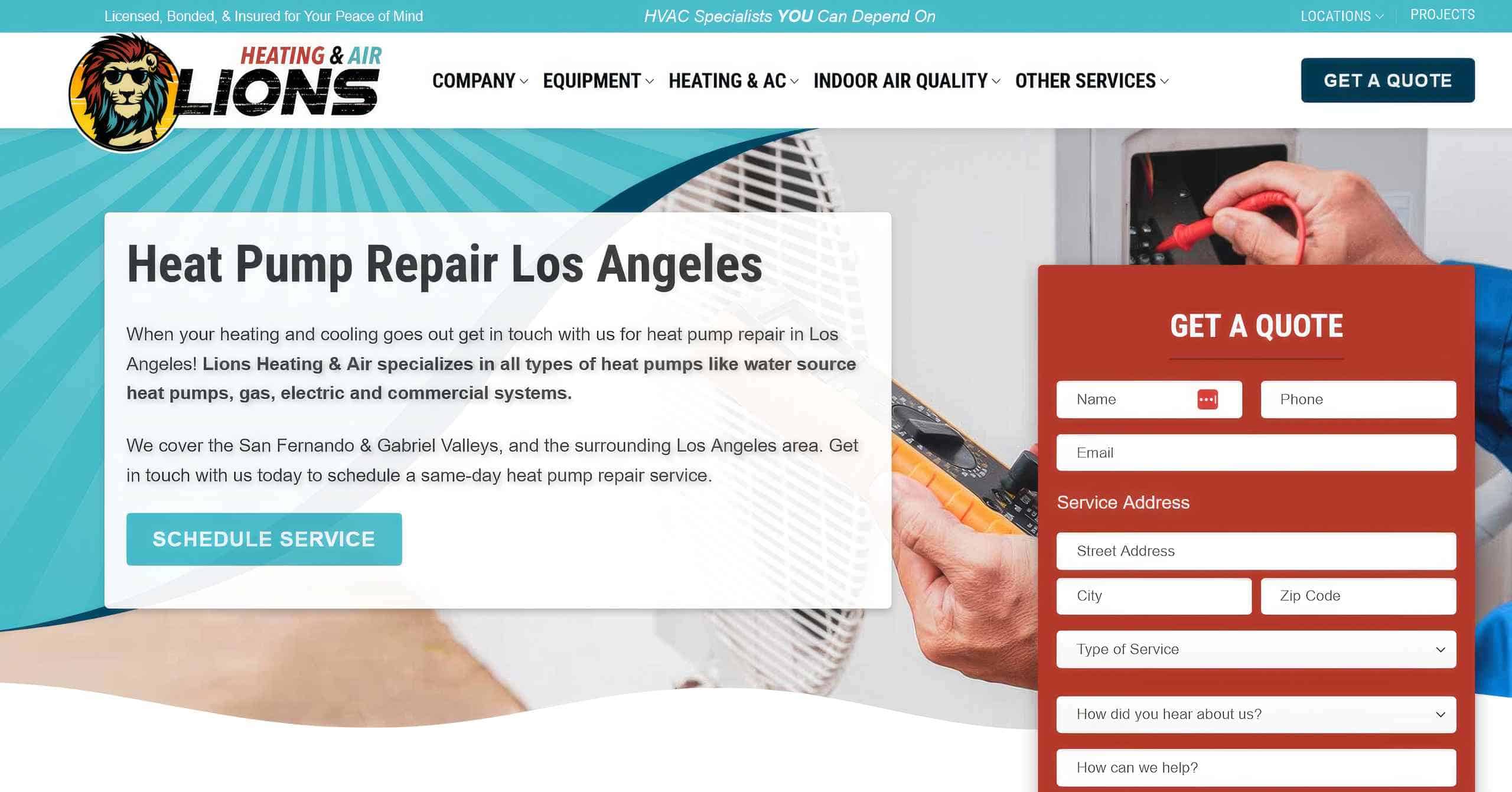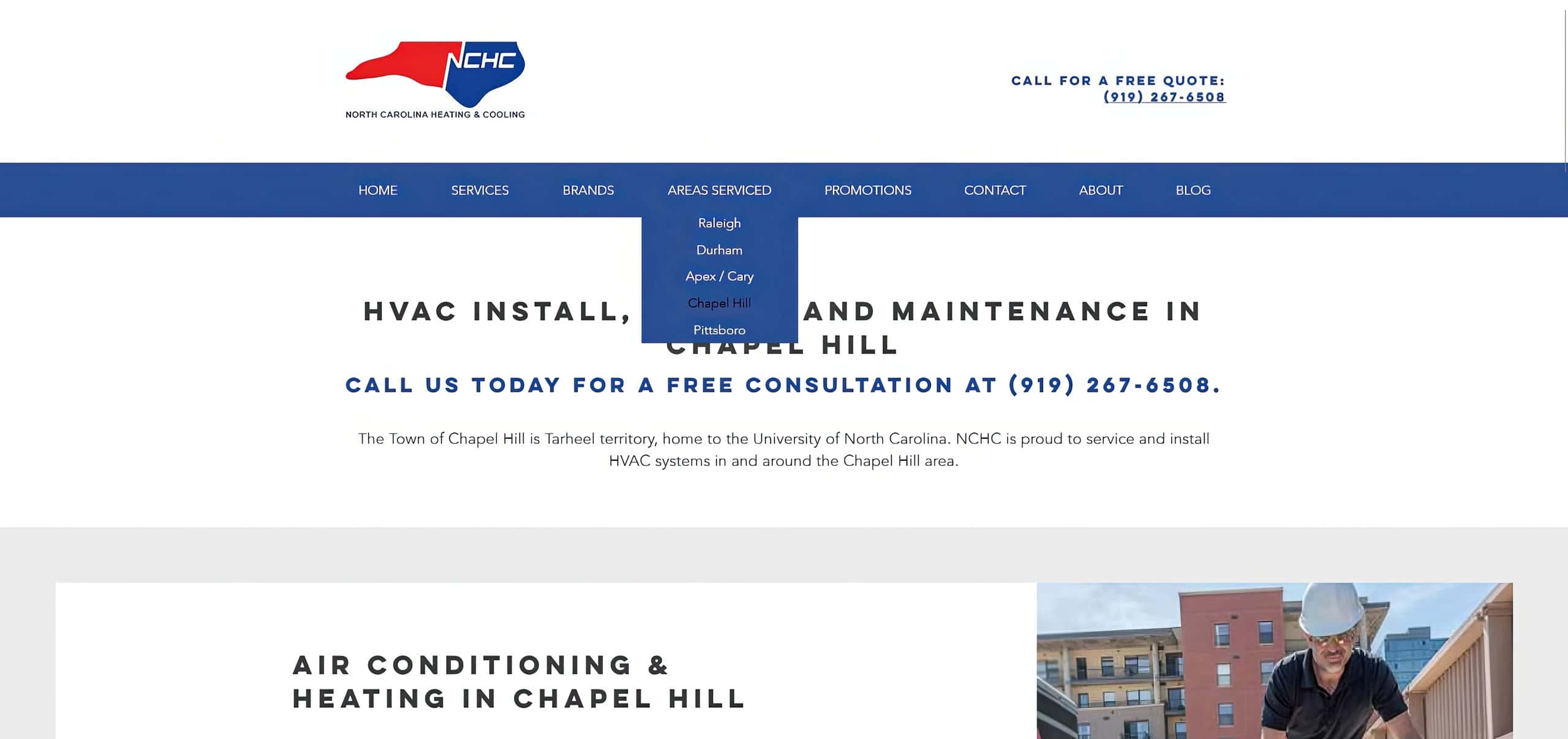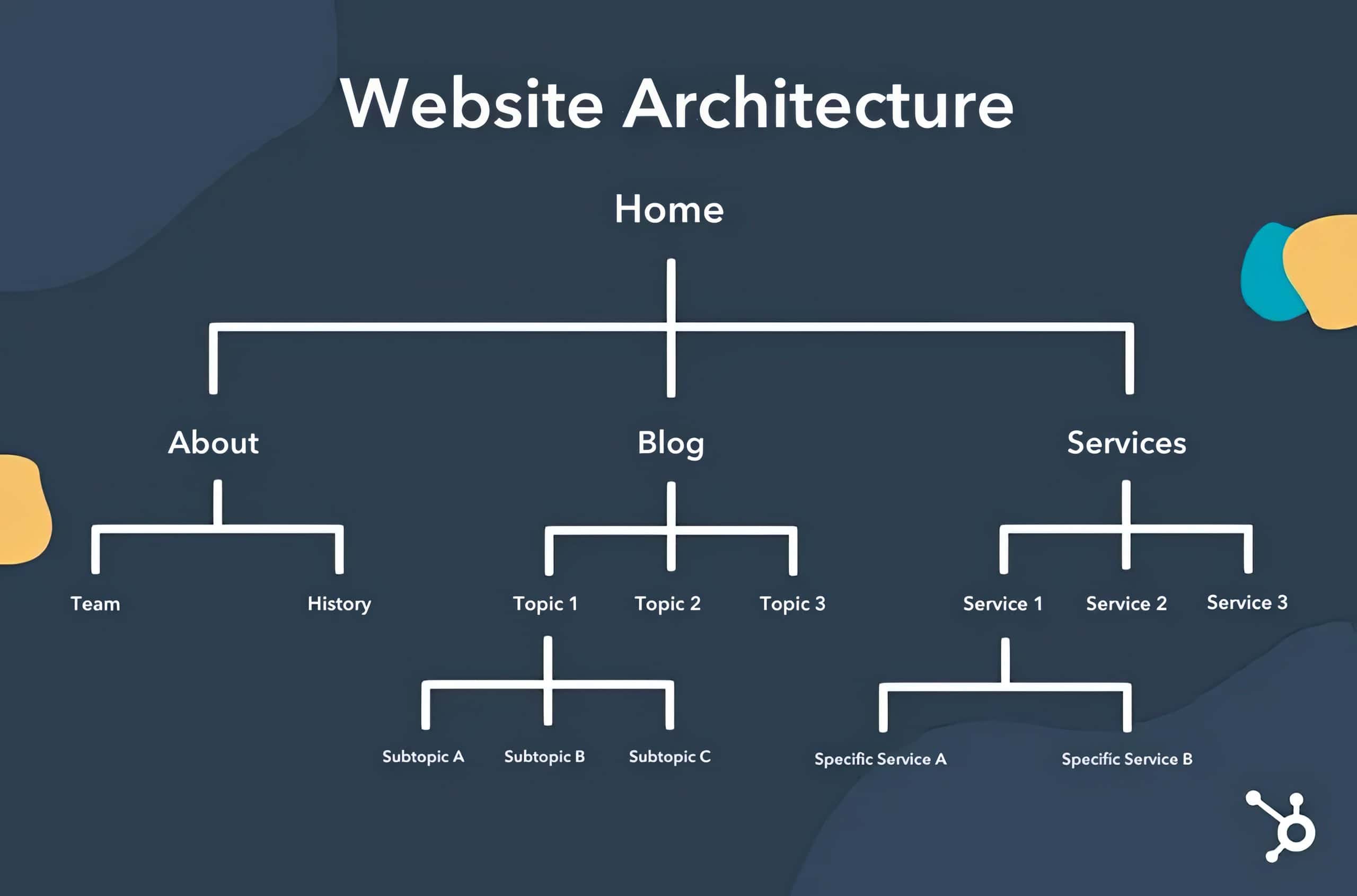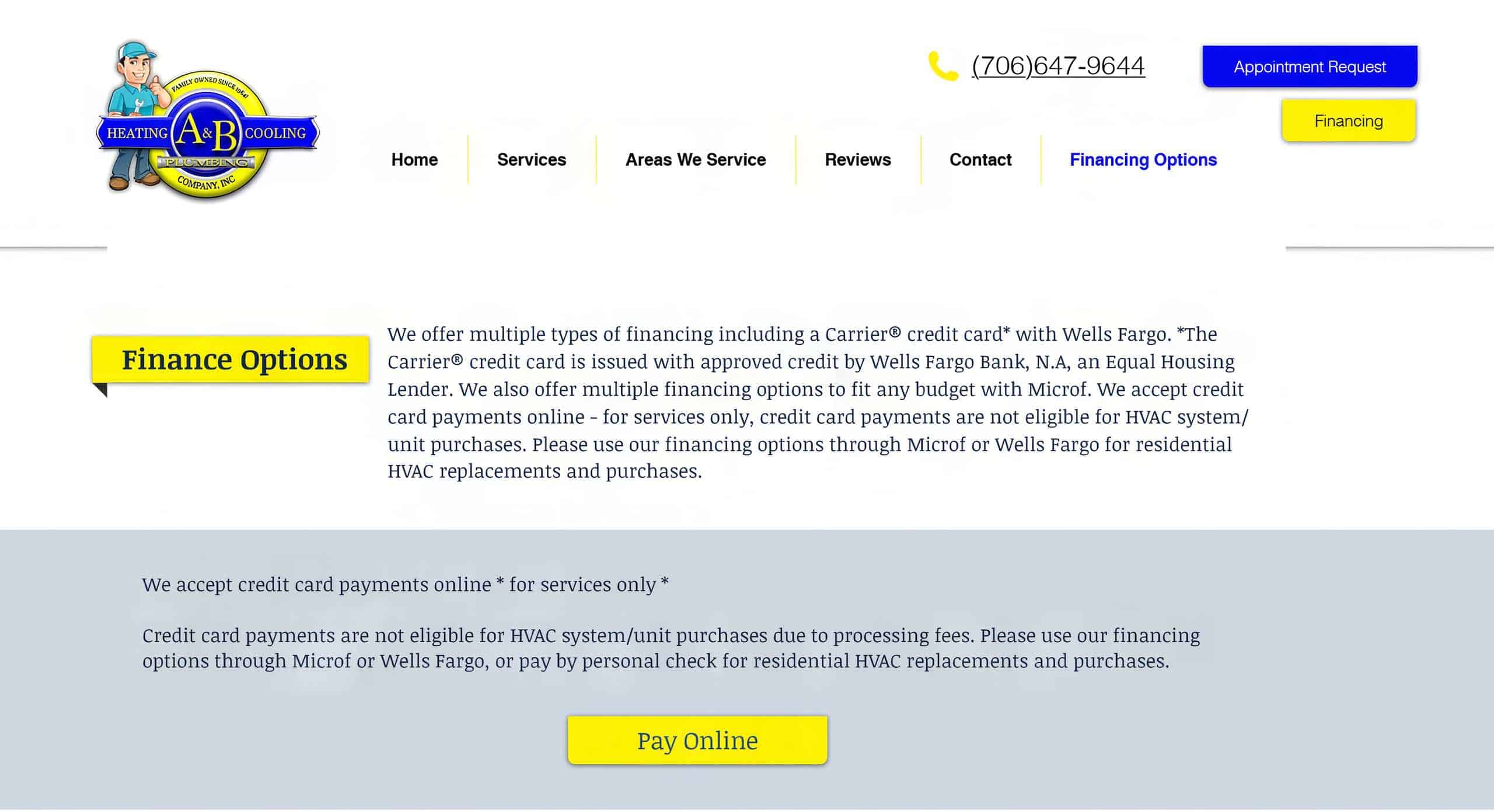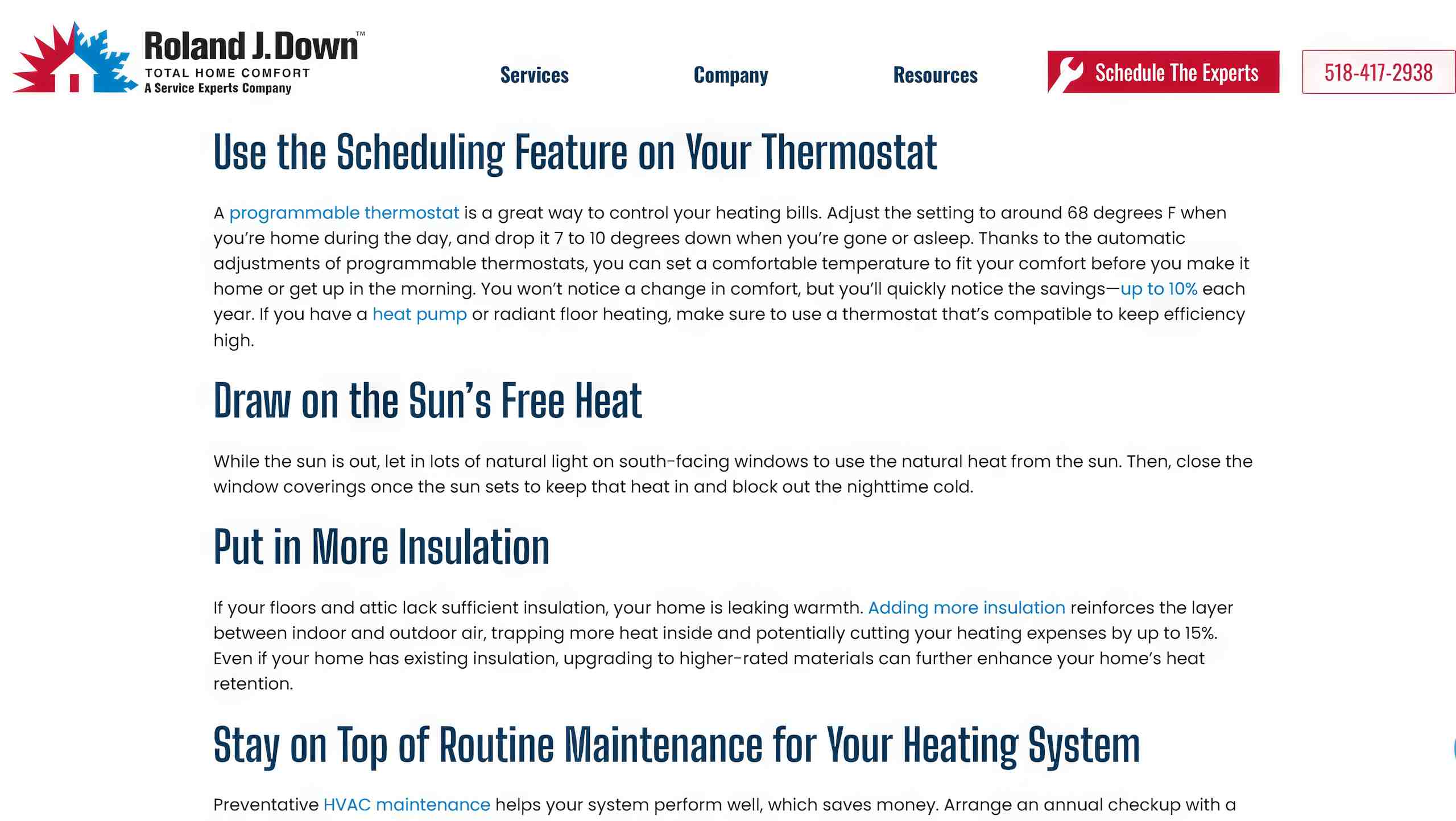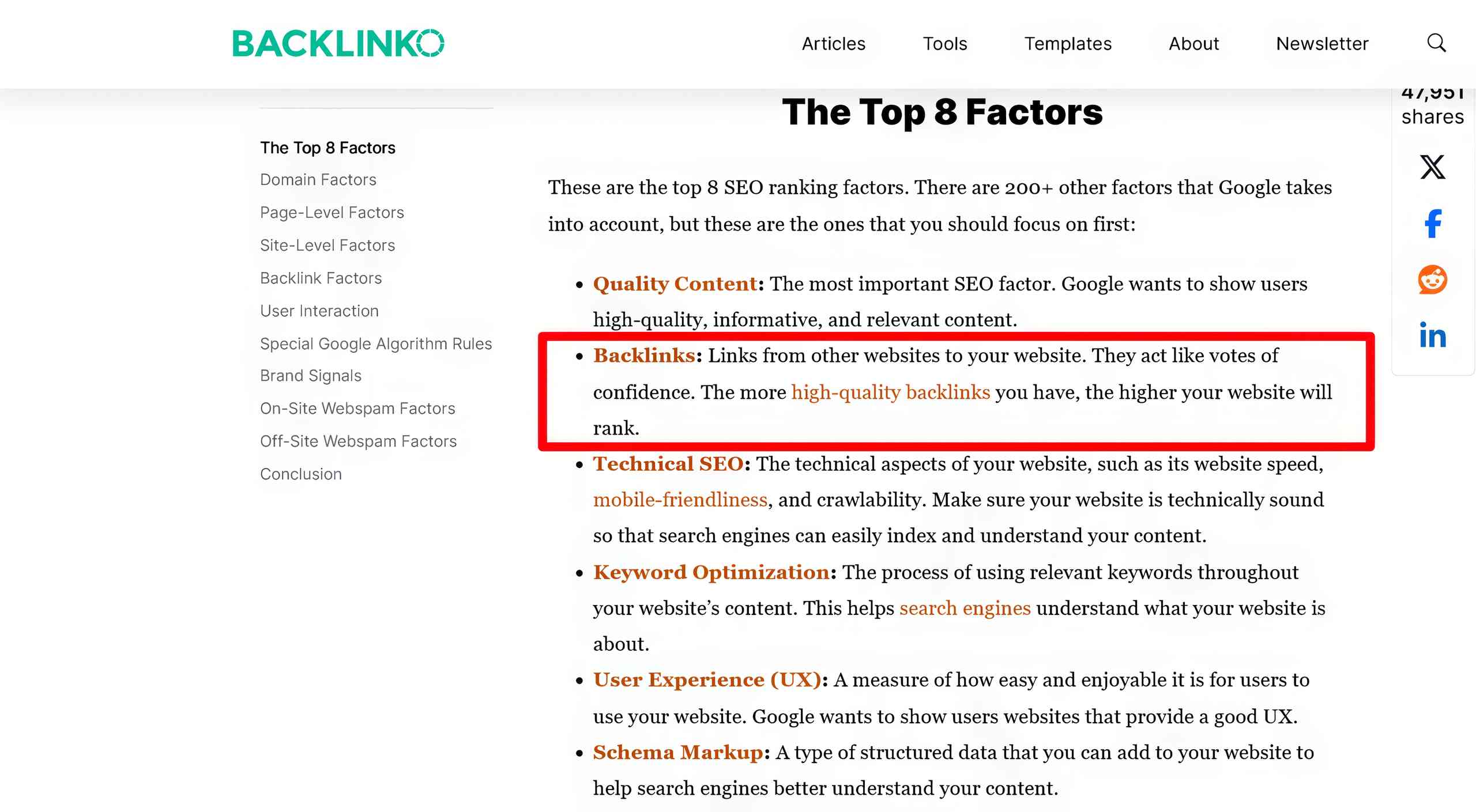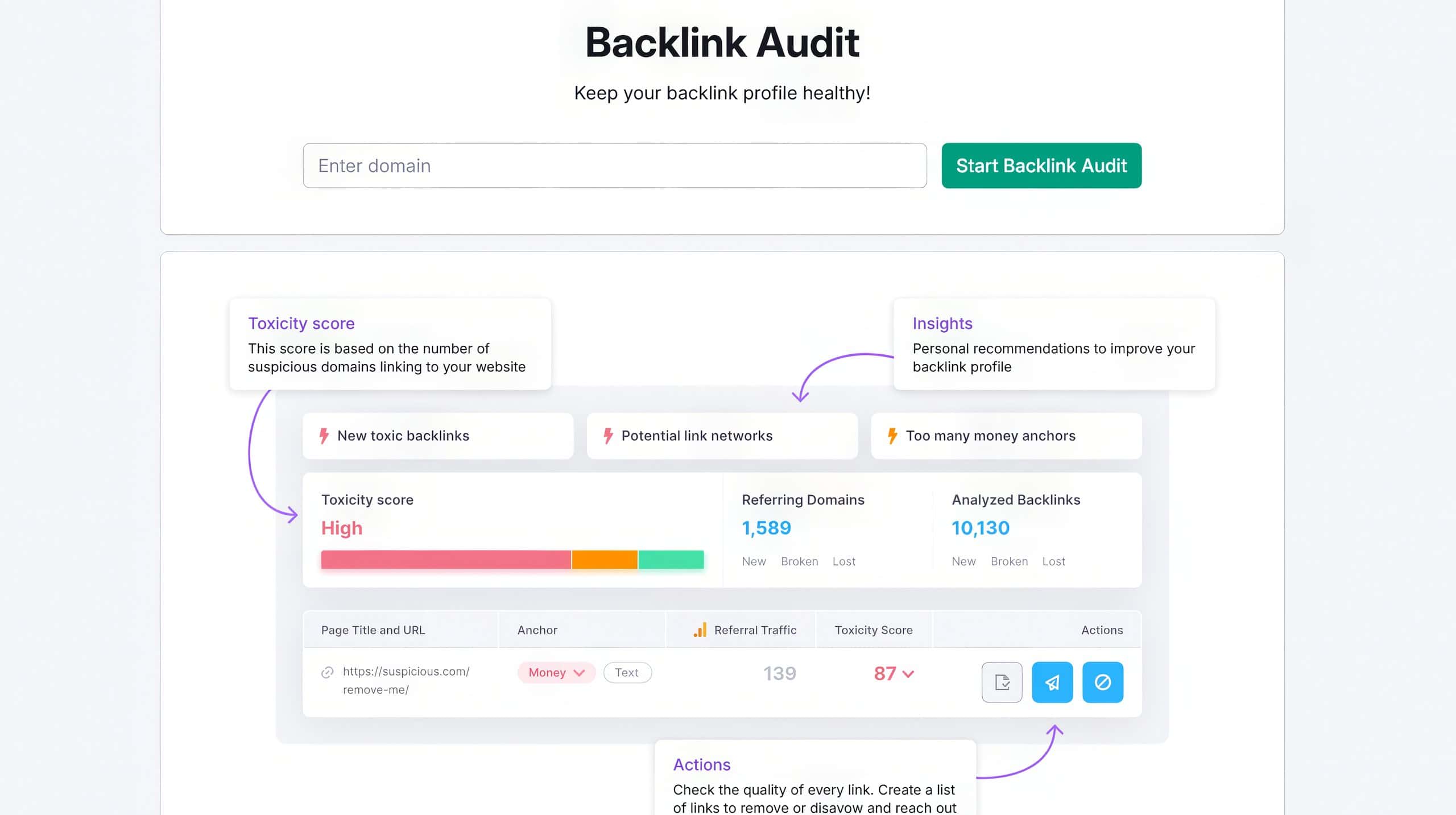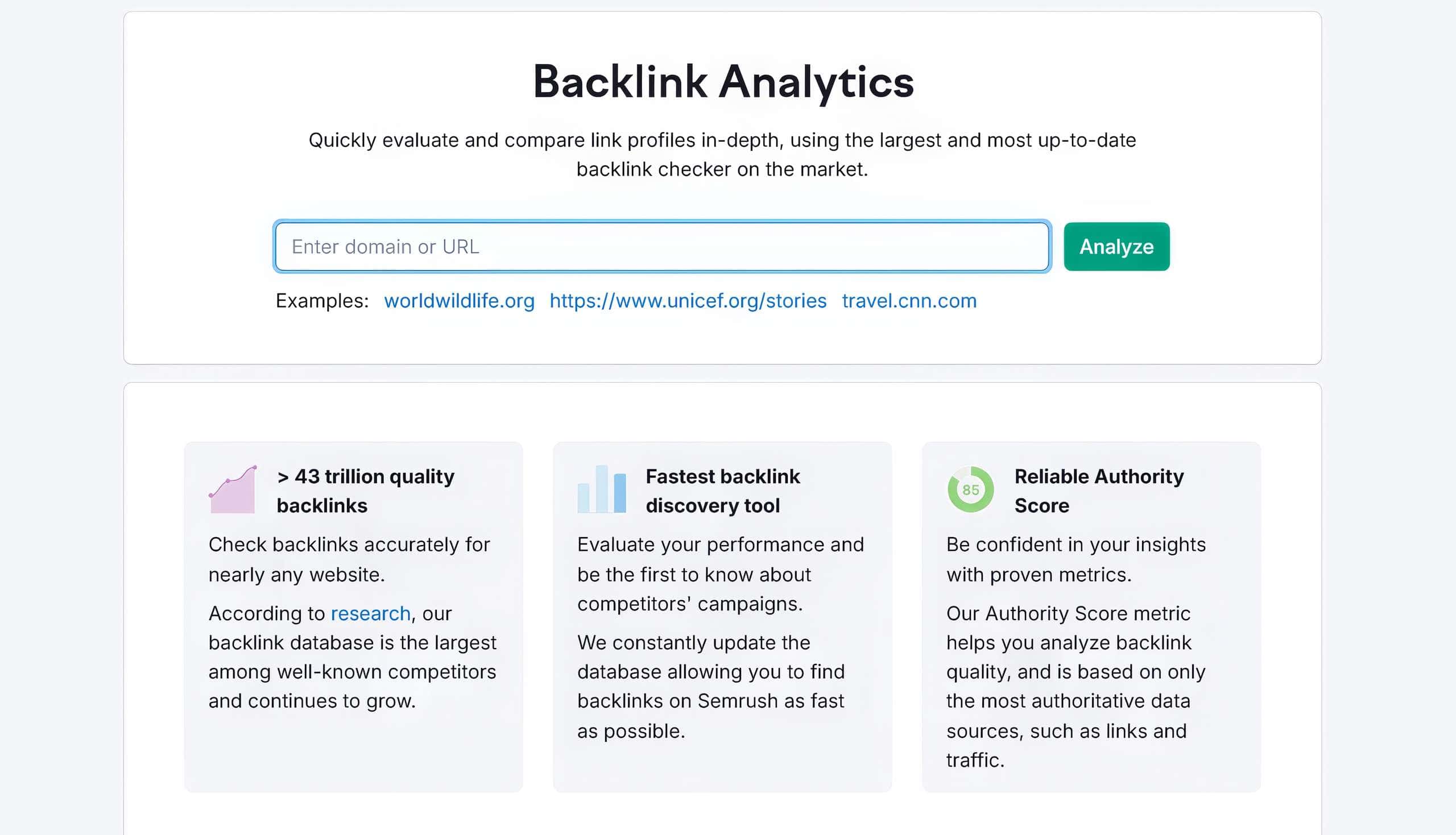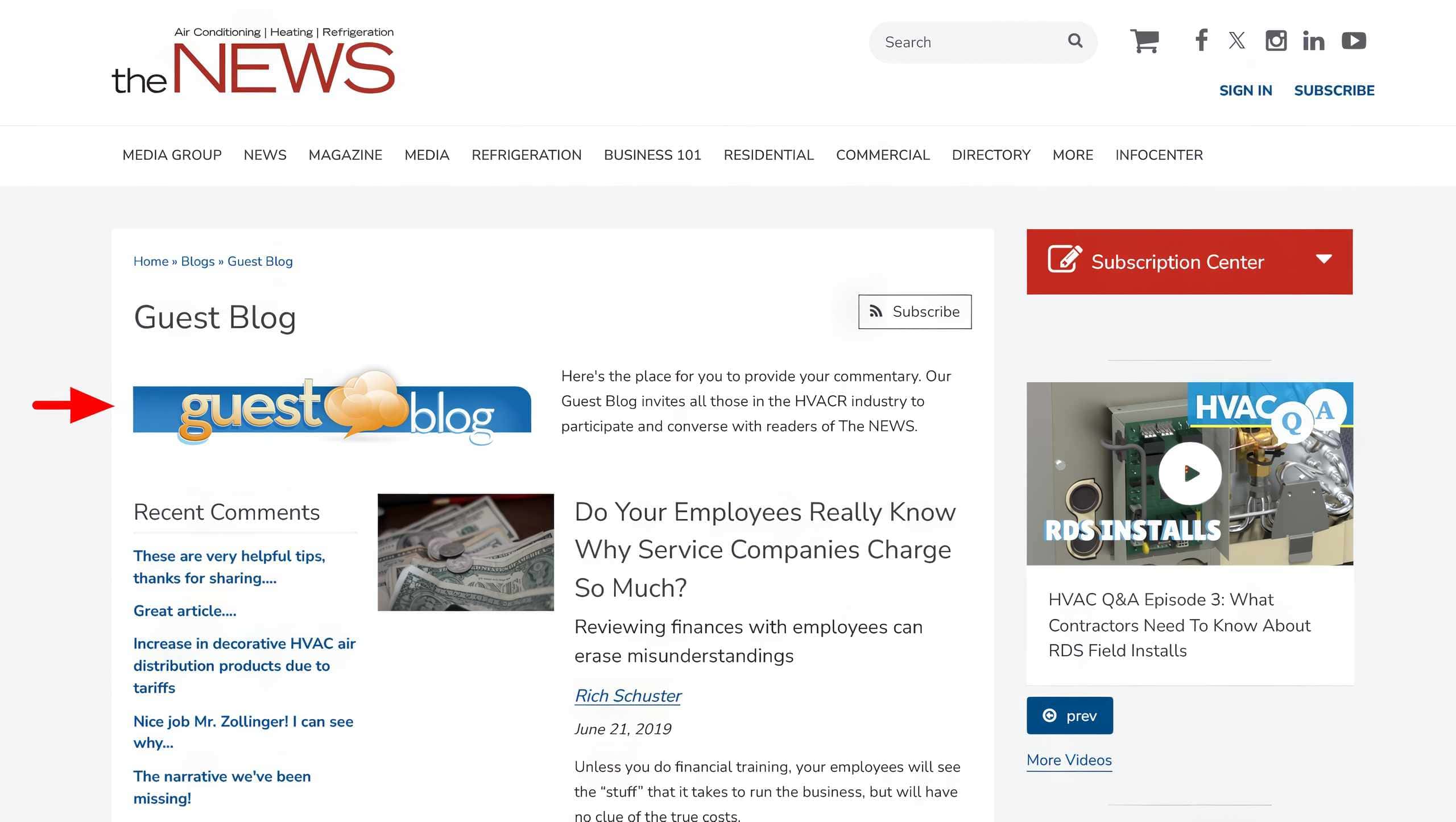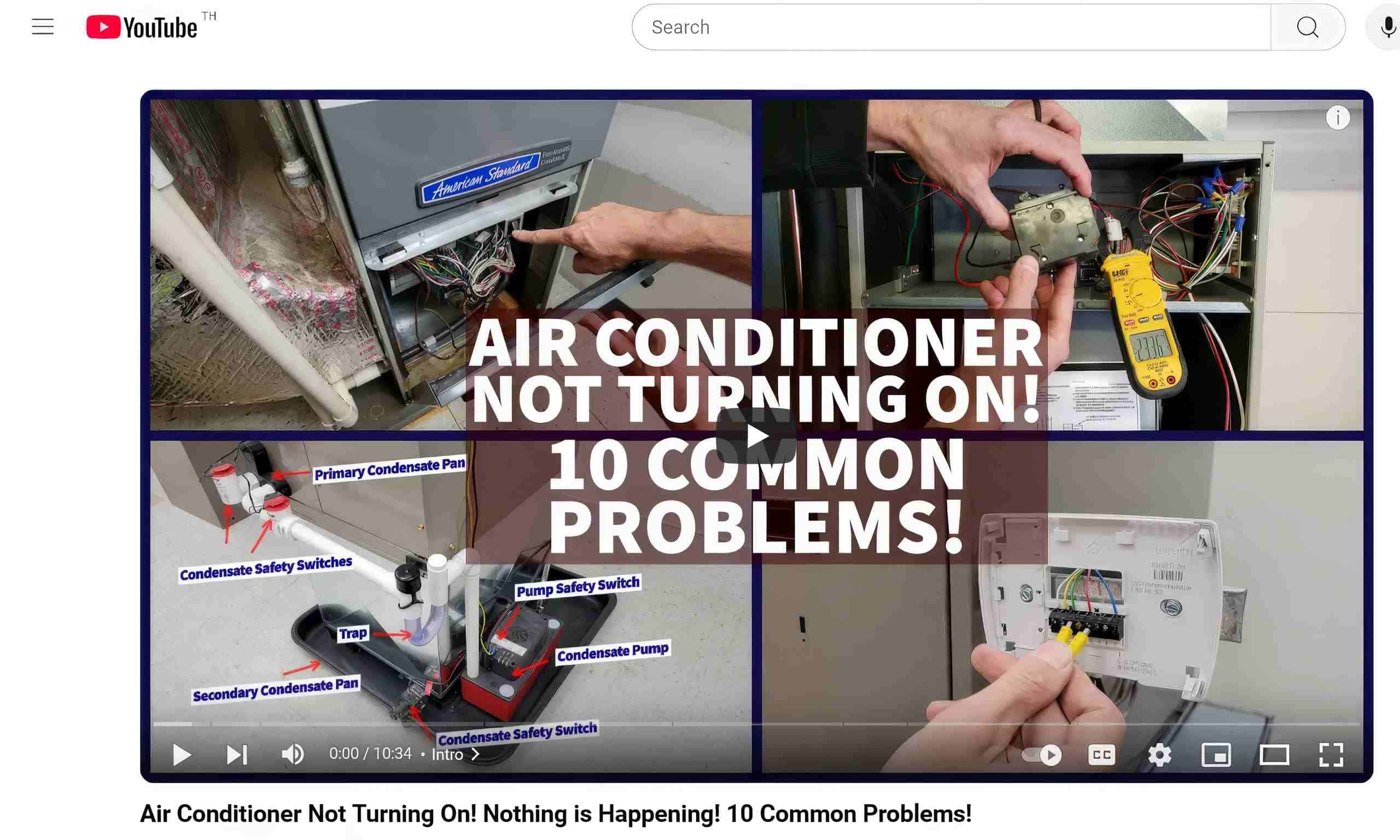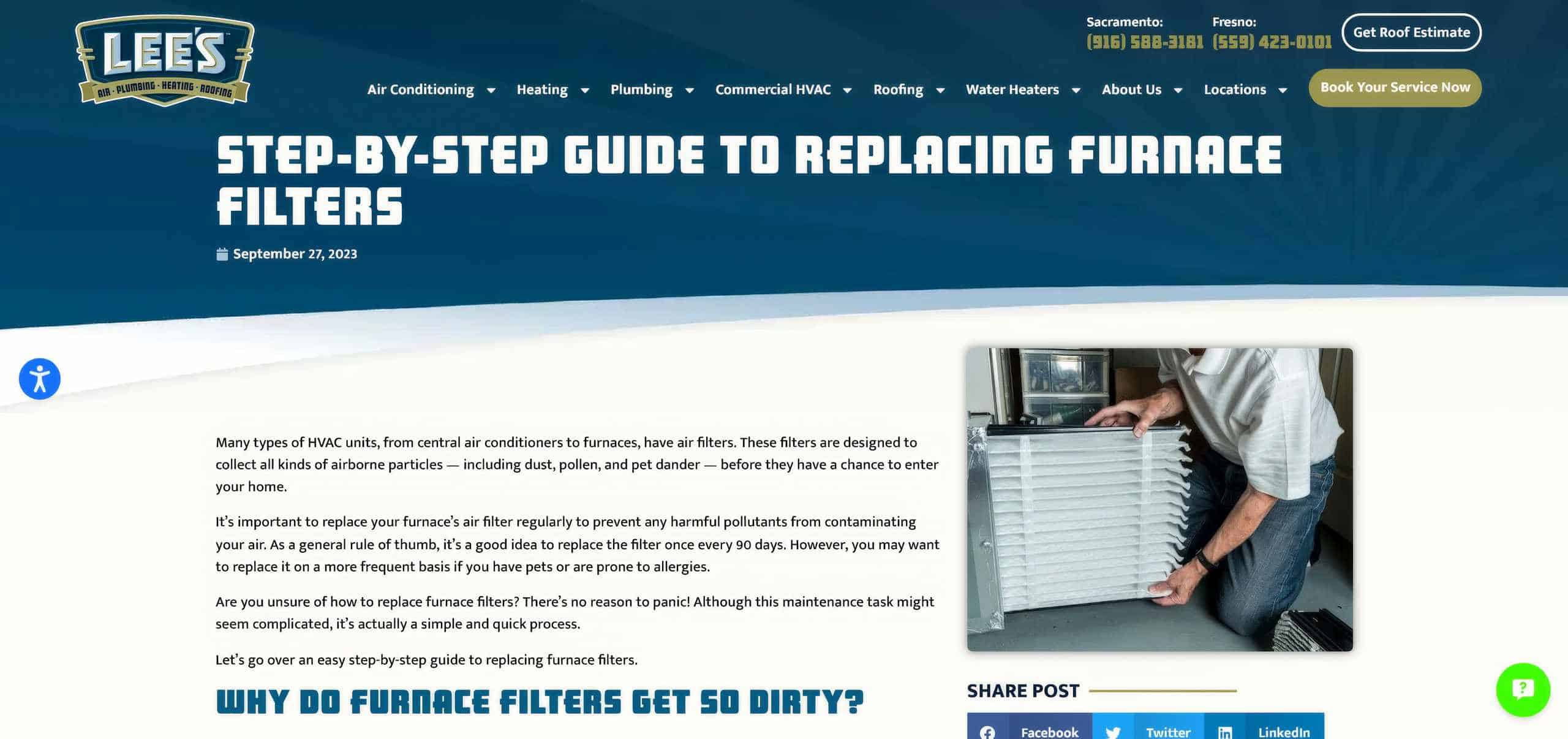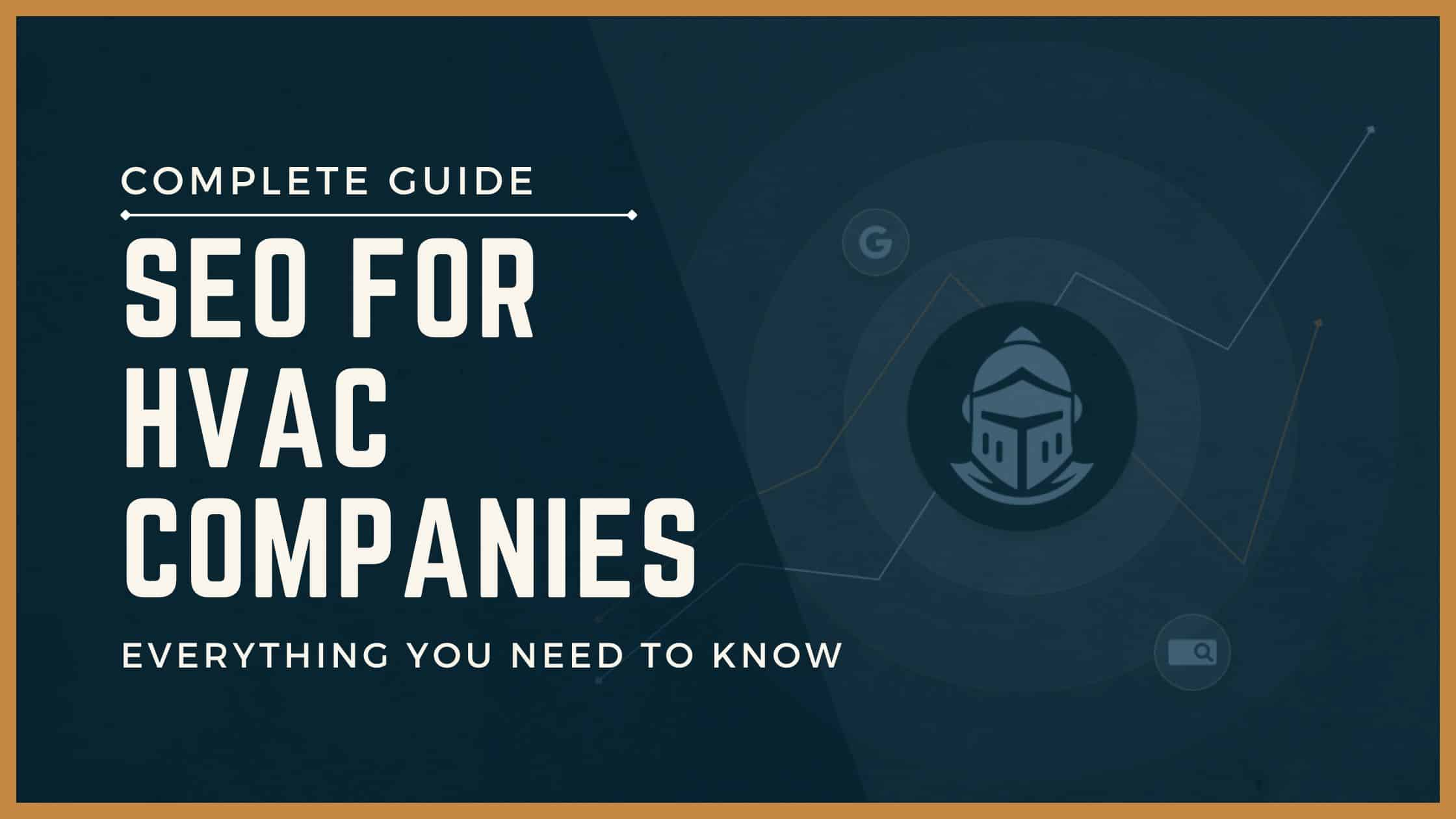

Why is your HVAC company practically “invisible” in the search engine rankings?
By “invisible,” I mean not on the first page of Google—because less than 10 percent of searchers go past the first page.
It’s not because the other companies provide better-quality air conditioners, furnaces or heat pumps—or install or maintain them more professionally. It’s simply because your HVAC company has not yet cracked search engine optimization (SEO)—and competing businesses have.
That starts to change here. By taking on board the following information on SEO for HVAC companies and implementing the necessary strategies, you will lay the foundation for long-term success with HVAC lead generation and growth…
What Is HVAC SEO and Why Is It Important?
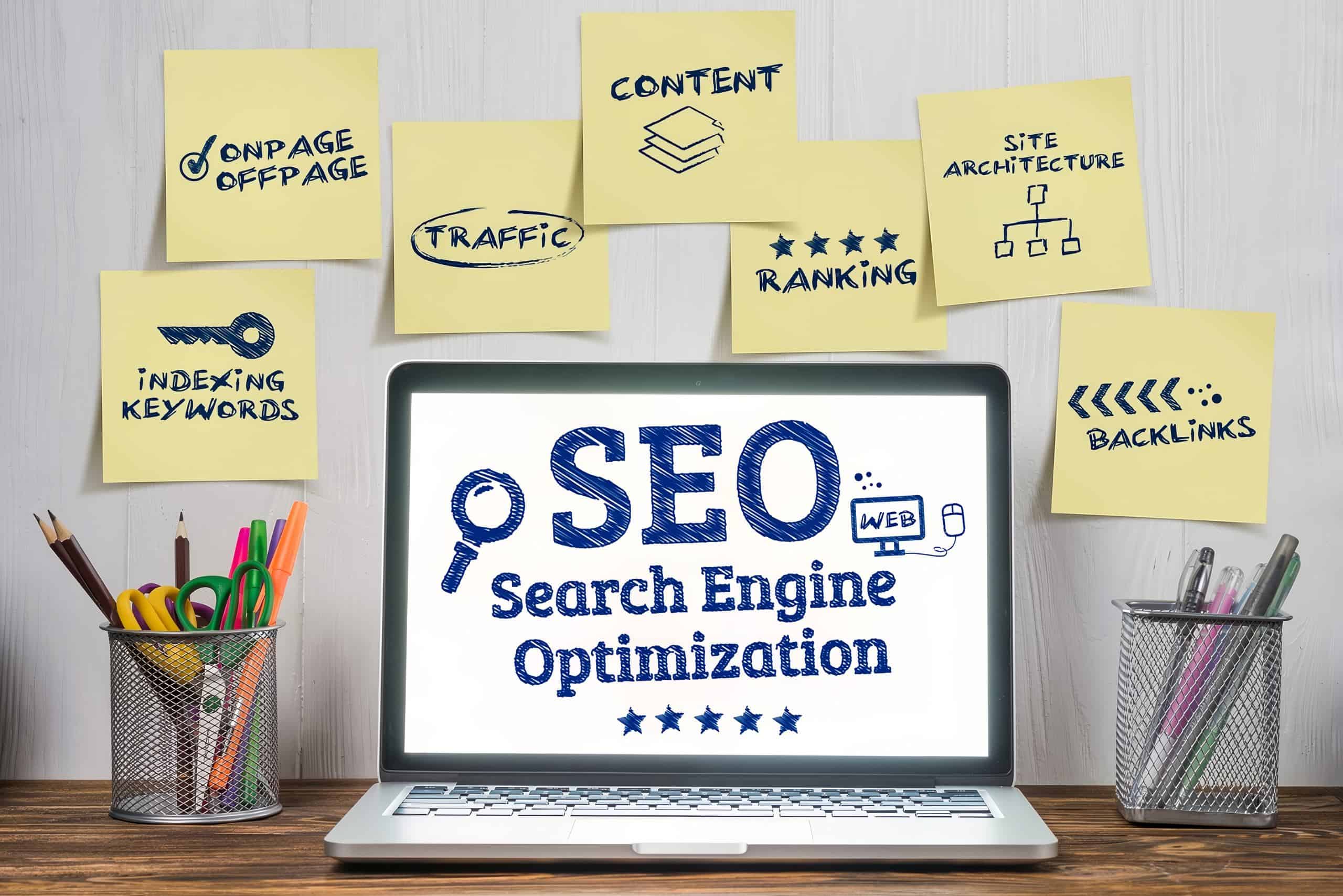
HVAC SEO refers to strategies that organically increase an HVAC company’s website’s visibility in search engines—without spending a cent on Google Ads or Google Local Service Ads.
You can attract qualified leads, build credibility, and grow without an unmanageable marketing budget with these cornerstone SEO strategies for HVAC companies:
To illustrate the importance of SEO in your HVAC business, let’s look at a quick example.
Say the AC breaks down in your Chicago home in the middle of July. What do you do? You go online and search for repair services…just like thousands of other homeowners who have the same problem every day.
I searched Google for “AC repairs in Chicago.” At the top of the search engine results page (SERP)—just below the Google Ads—you first see the Google “Three-Pack” or “Local Pack”:
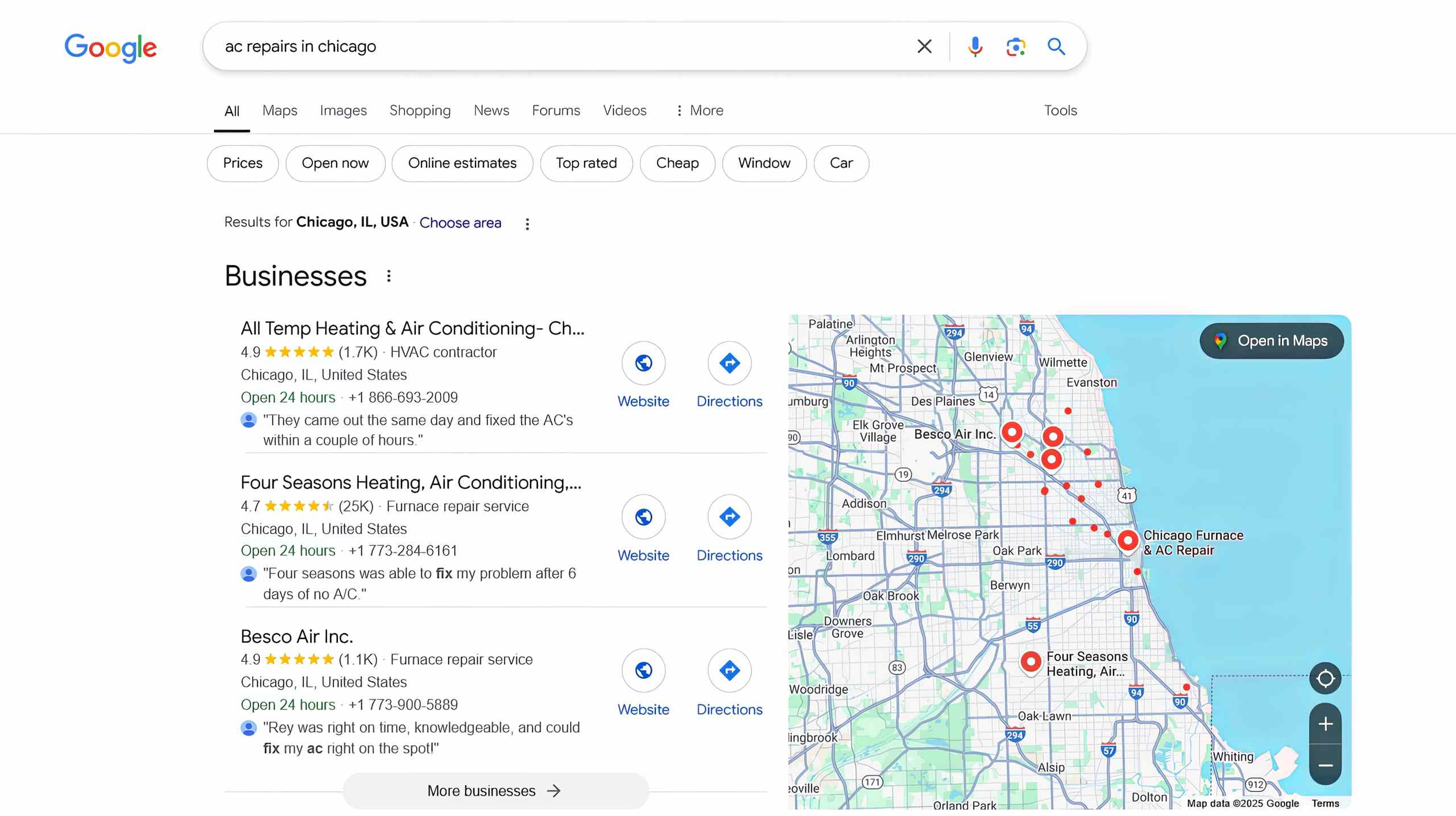
The HVAC company Four Seasons features alongside two other businesses in this prime Google “real estate.” The three companies are pinned on the accompanying map.
Then, scrolling down, you see this below the Three Pack:
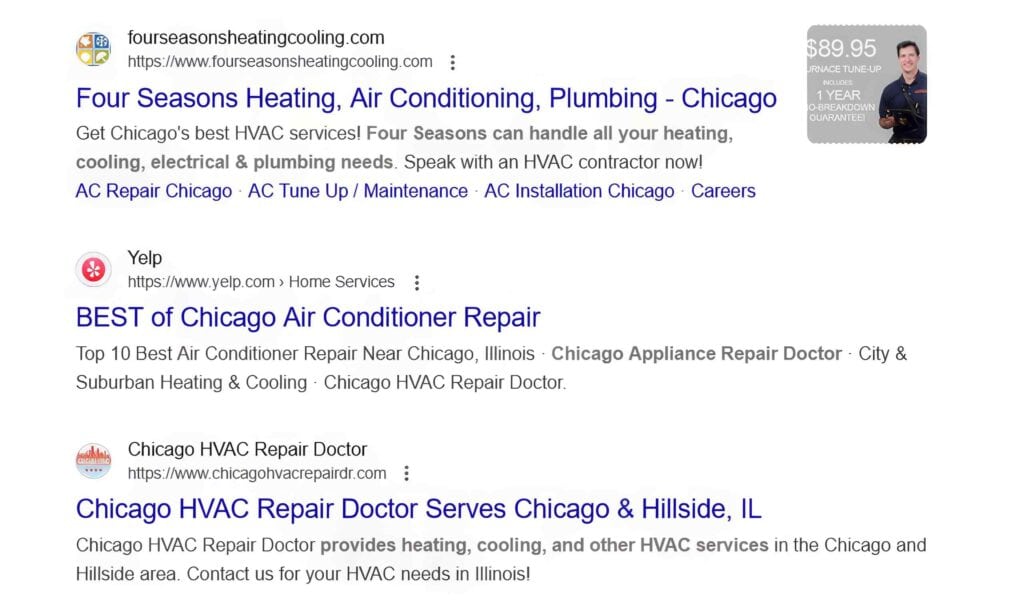
The Four Seasons company is the first website that features. Then, further down below the “People Also Ask…” section, there’s this:
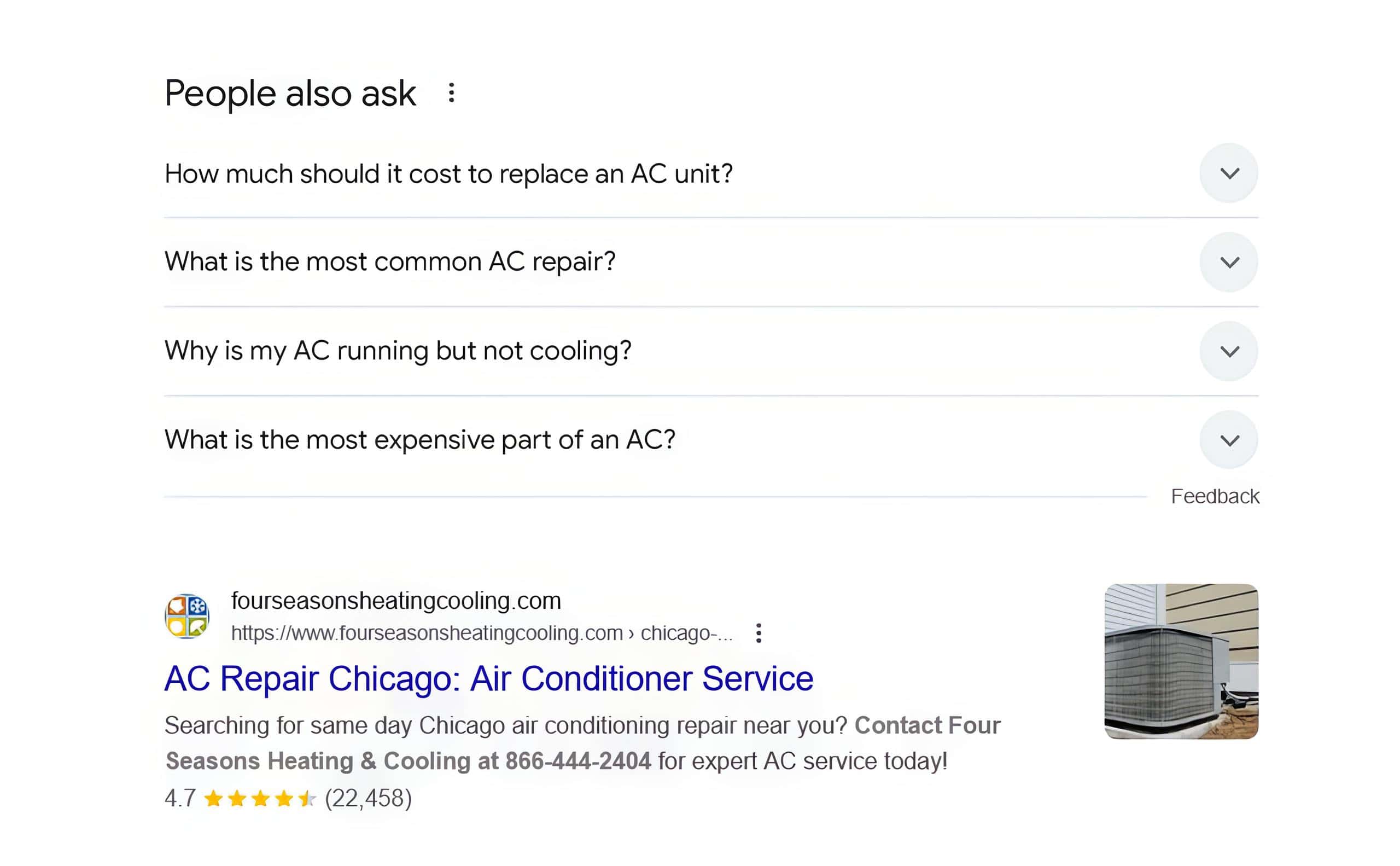
So, Four Seasons dominates the SERPs for “AC repairs in Chicago.” Who are you going to call if you need AC repairs in Chicago? Four Seasons or a company buried on Page 5 of Google and essentially “invisible.”
Ranking at or near the top of Google Page One for your targeted SEO terms and dominating the local search results sets your HVAC website up to become the 24/7 lead-generating machine you always hoped it would be… all with no direct outlay for ads.
That’s why SEO is one of the leading HVAC marketing strategies to implement in your business.
HVAC Keyword Research
HVAC SEO starts with keywords. Even if you hire an SEO specialist to look after search engine optimization (normally advisable as few HVAC companies have the know-how or resources to do this themselves), it pays to understand the basics.

Keyword research is the process of identifying the key search terms that your SEO strategy will target. The obvious ones for HVAC companies are terms like “furnace maintenance,” “emergency AC repairs,” and “heat pump installation.” Only targeting the terms every HVAC company wants to rank for will not usually get you far with SEO.
To target the best keywords, consider the following:
Fortunately, some well-established (and rather smart) tools can help establish what you need to know with keyword research.
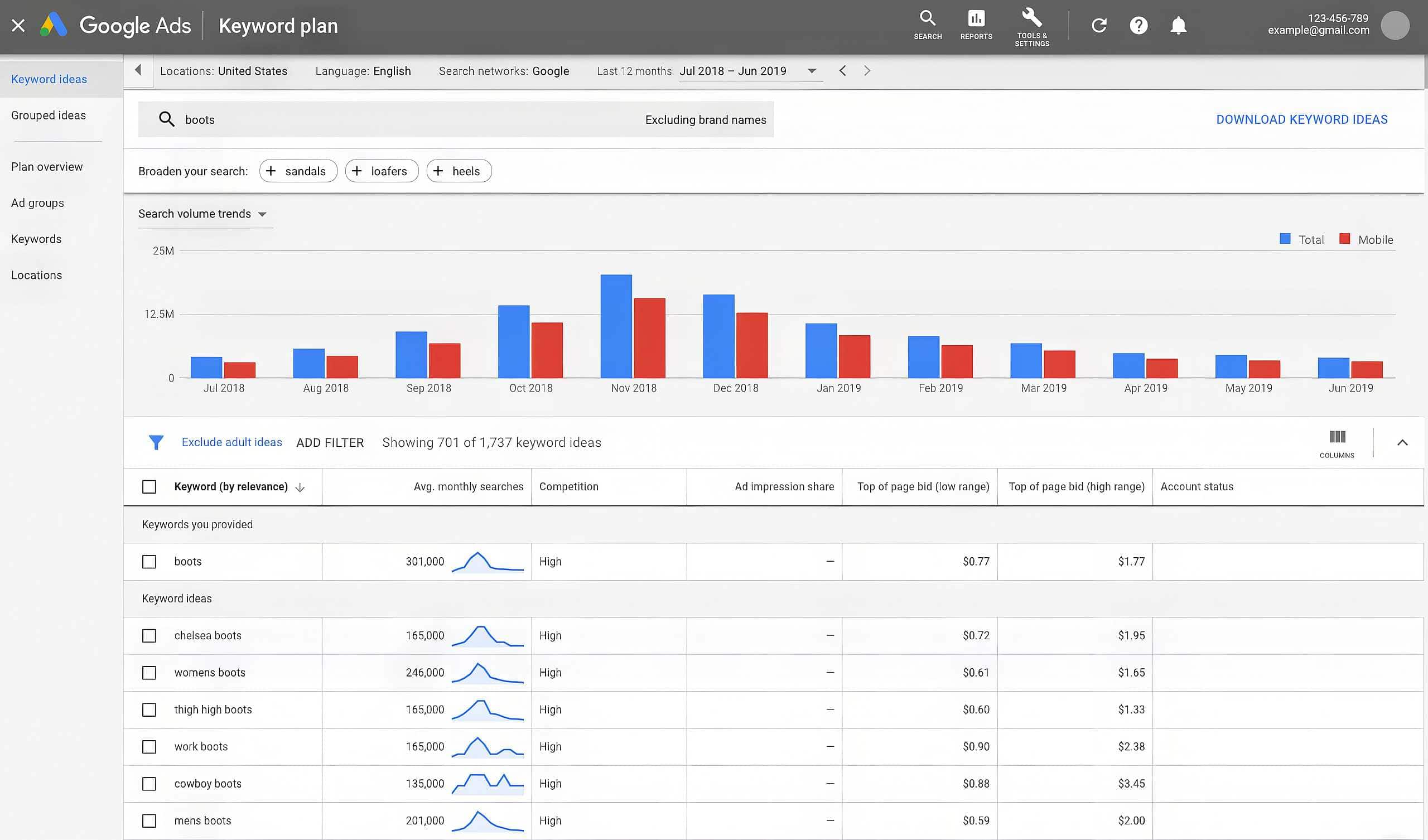
What Are the Best Keyword Research Tools and What Will They Tell You?
The best tools for keyword research are Google Keyword Planner, Semrush, and Ahrefs:
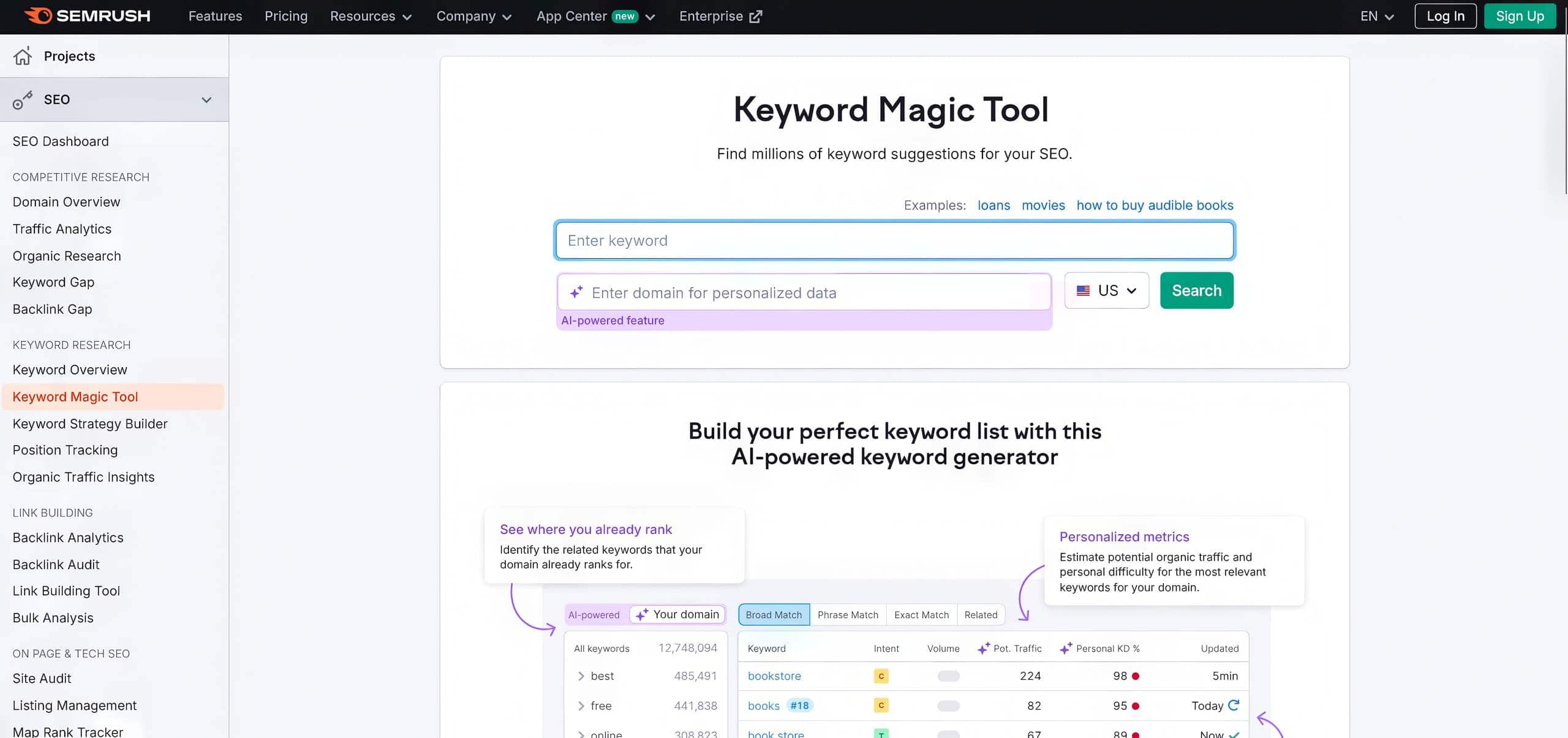
If you enter a broad keyword term like “HVAC company” into the Keyword Magic Tool, you will receive a long list of keyword ideas and key information about each term. This includes search intent, volume, and keyword difficulty.
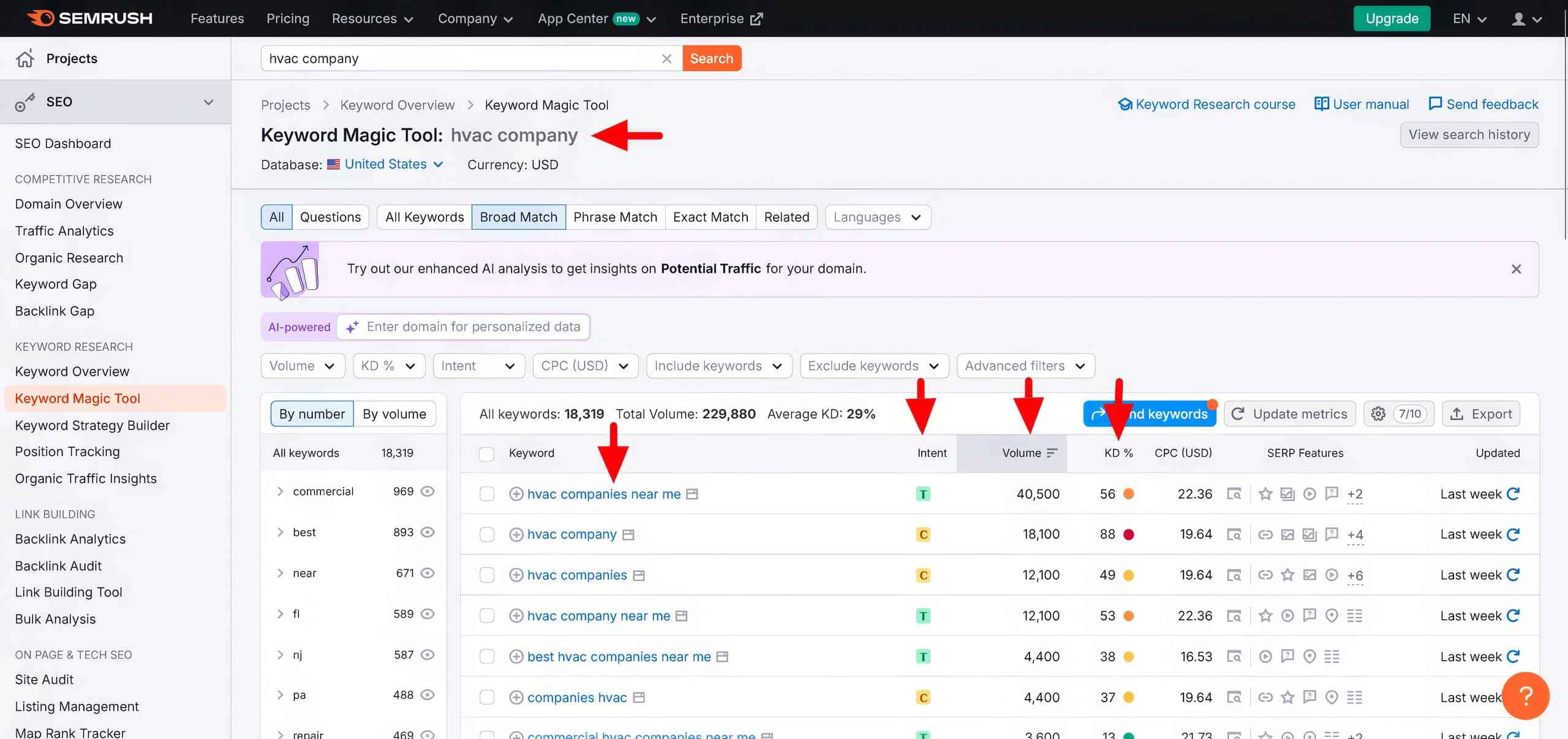
Search intent is key because it tells you what the user expects after typing the search term in Google. The four types of search intent are:
Someone searching for ”furnace company” usually has commercial intent, i.e., the user wants to research the best furnace company and see their services.
Using commercial intent keywords on service pages like furnace installation or furnace repairs makes sense.
However, someone searching for “Why does my furnace smell like burning?” has informational intent because they want to know if their furnace has a particular problem that needs fixing. Using these types of keywords on resource pages like blog articles or videos makes more sense.
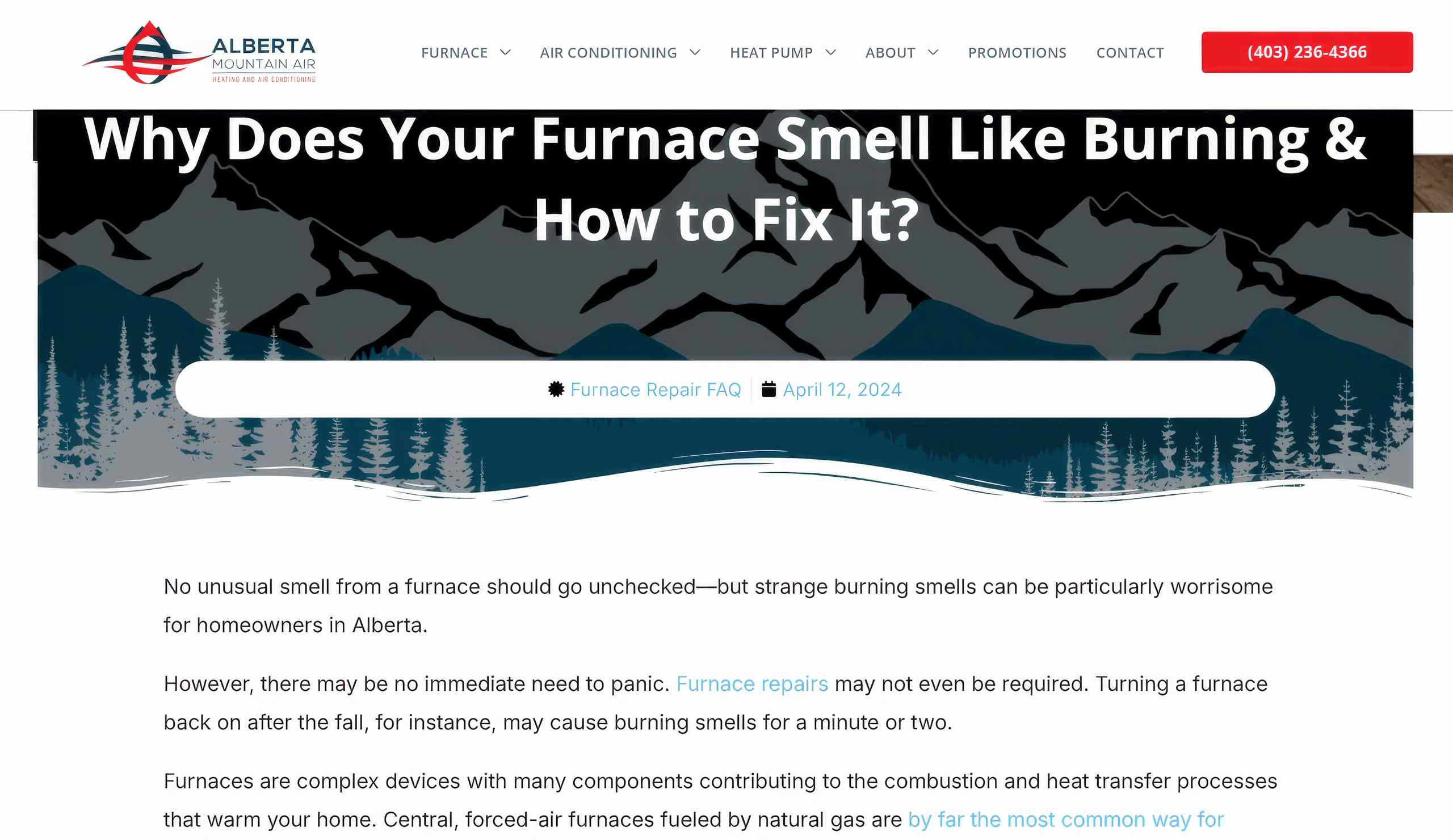
Target a Variety of Search Terms
The general rule for HVAC websites that are not yet well-established is to target a variety of keyword terms: from highly competitive broad terms like “HVAC company” and “furnace repairs” to more specific location- and FAQ-based terms, like “emergency AC repairs in Calgary, Alberta” and “how do I find the right size of furnace for my home?”
These latter terms with local modifiers usually have a moderate search volume but, critically, when you’re not very established, lower competition.
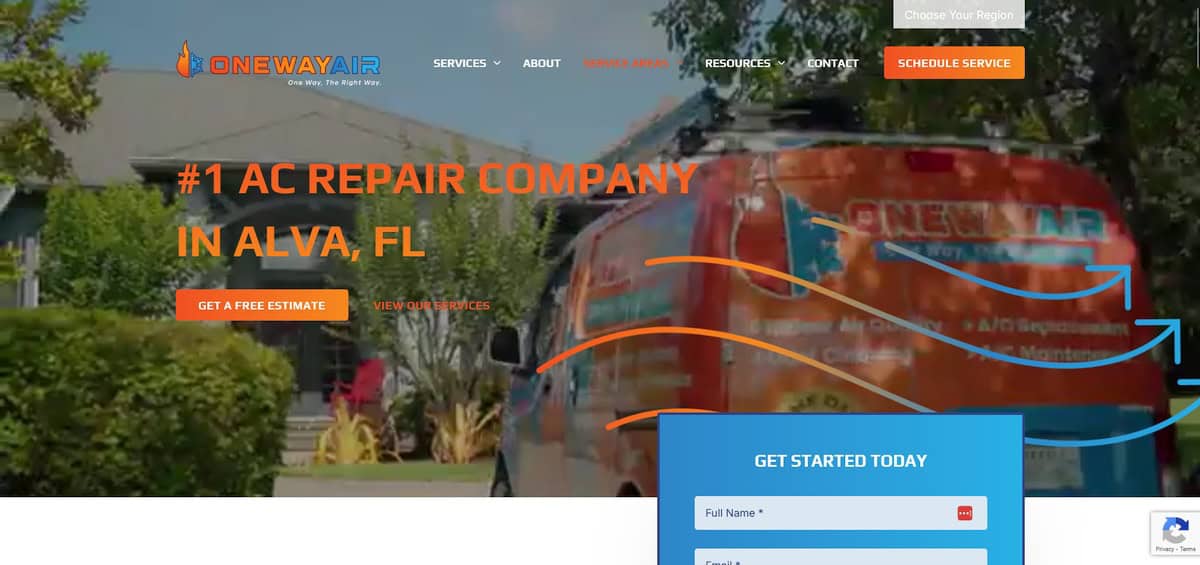
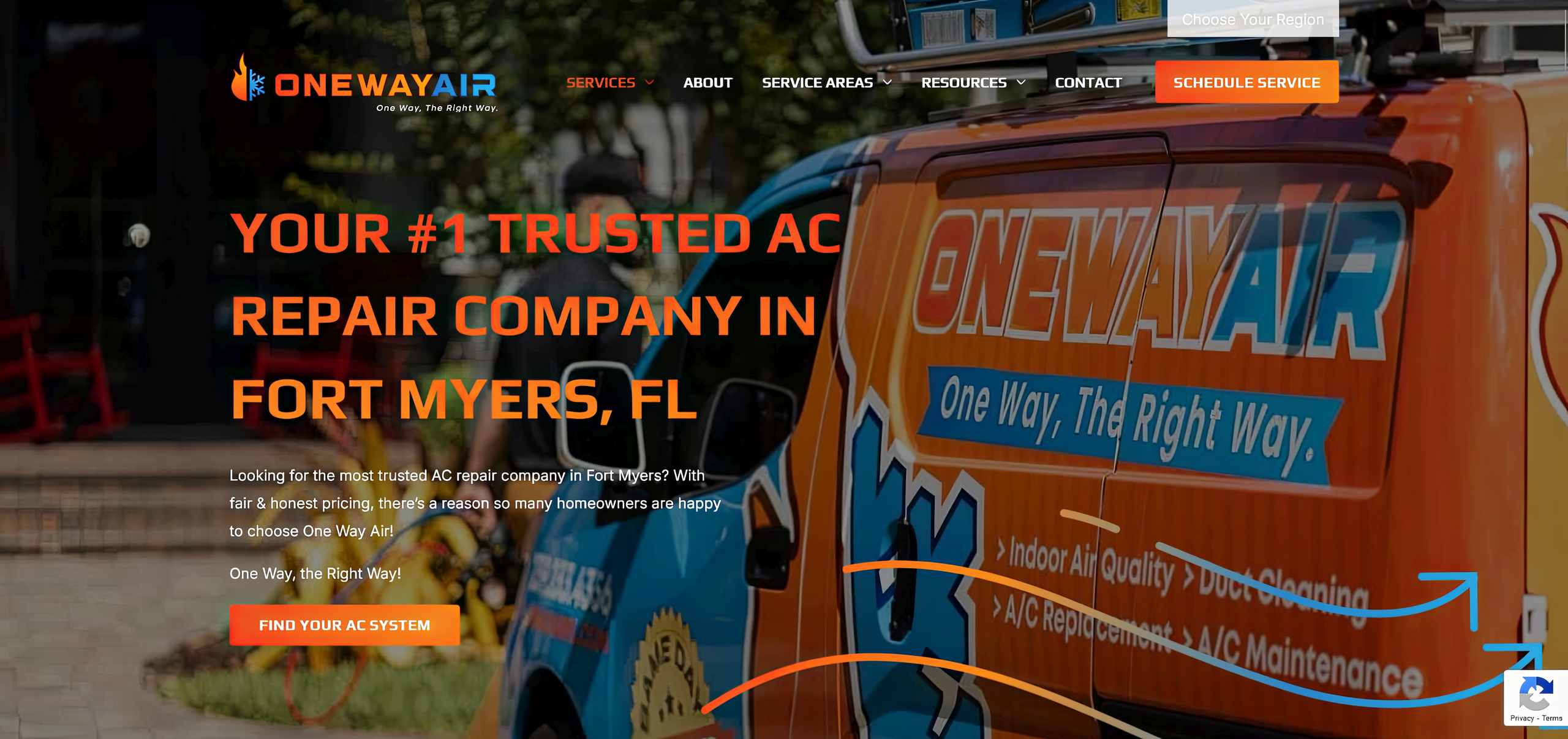
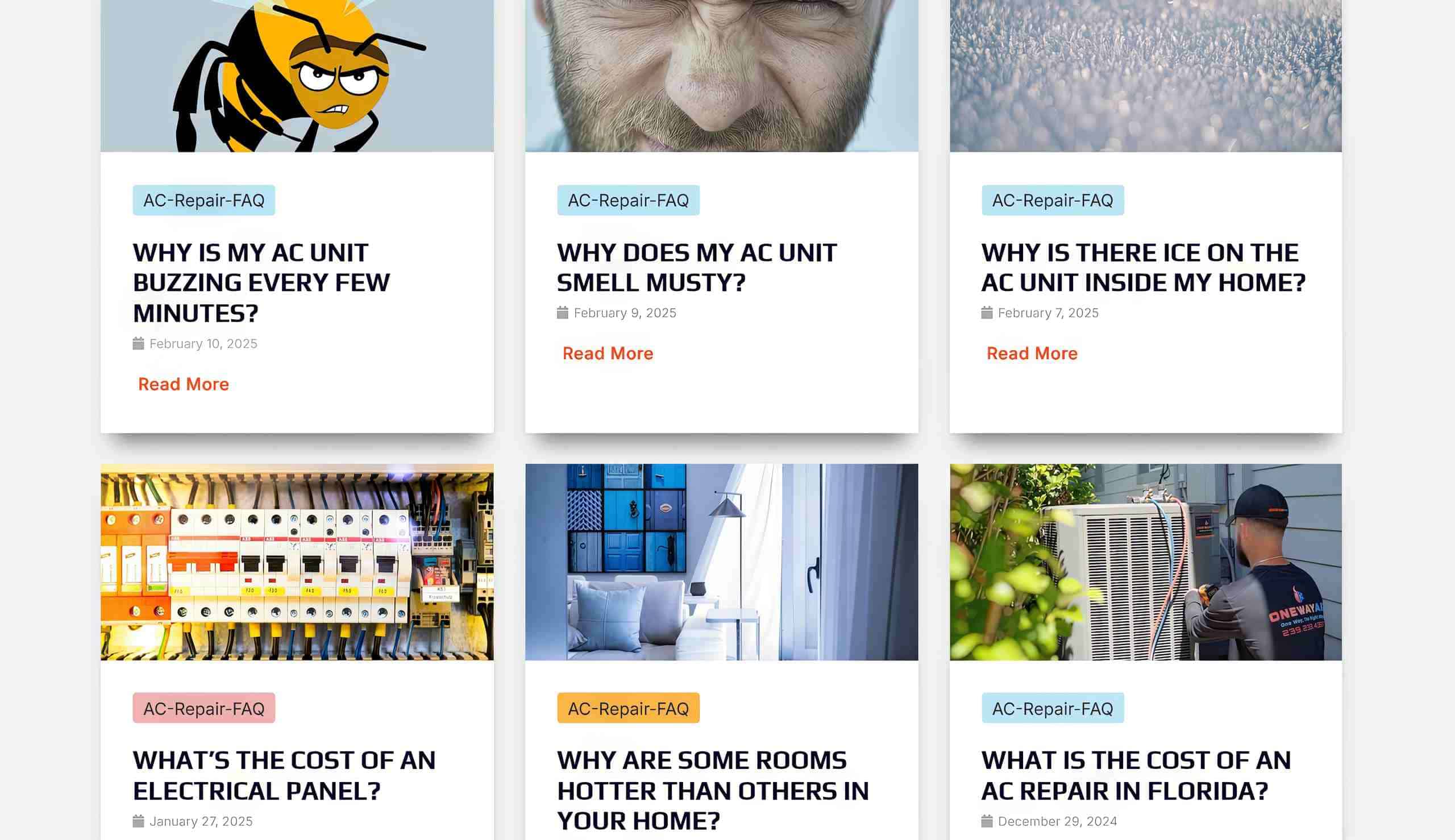
Research Competitor Keywords
As the final part of your keyword research, identify the keywords that your main competitors are targeting. You don’t need to reinvent the wheel—simply reverse engineer what they’re doing (if they’re successful).
Semrush’s Keyword Gap tool can help. It’s easy to compare your HVAC website’s performance to up to three competitors. Simply type in your website’s URL and the competing URLs, and click COMPARE (note that the free version restricts your activities to 10 searches per day).
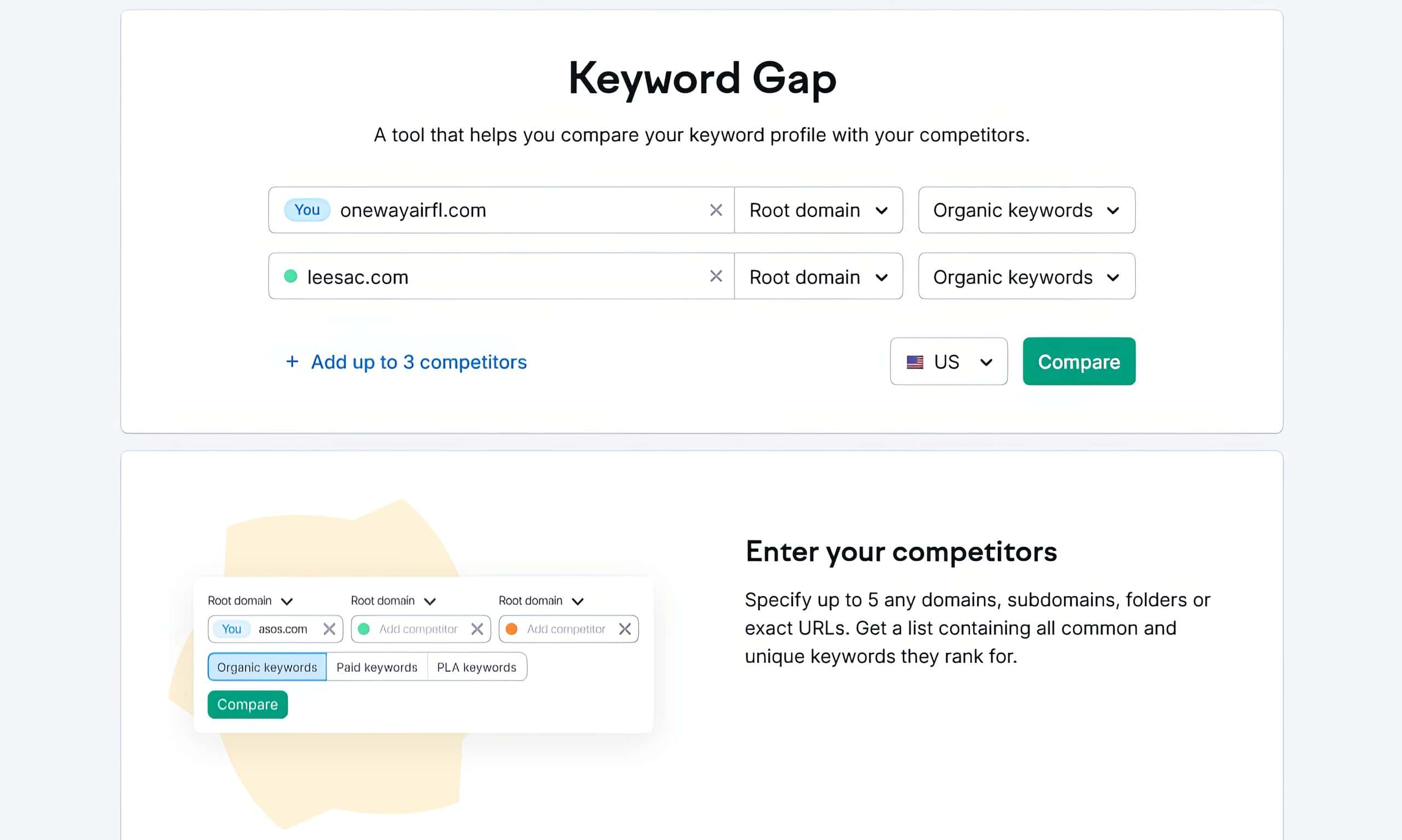
The tool will help you identify:
This data can inform your keyword-targeting strategy as you build content for your HVAC website. Focus on creating content that outranks your competitors by improving what they have produced.
On-Page SEO for HVAC Companies
On-page optimization means optimizing the content on your HVAC website for the keyword terms you identified during the keyword research phase—so that people searching for those terms are directed to the relevant pages.
Though content marketing is an important element of on-page SEO, that’s dealt with separately below. So, on-page optimization here refers mainly to optimizing the home and service pages that describe what your business does and how you do it:
Once you’ve identified the keyword terms to target, the most important on-page SEO strategies are:
Here’s a closer look at each strategy:
Seo-Friendly Title Tags and Meta Descriptions
Title tags should accurately describe the topic of the webpage because they are displayed as clickable headlines on the SERPs.
Use the major targeted keyword and make the headline unique on each page, descriptive, and concise (50-55 characters maximum, including spaces). Here’s an example from an HVAC company in Minneapolis:

As you can see from the above example, meta descriptions should describe what users can expect by clicking through. They should be professionally written, use targeted HVAC keywords, be persuasive, and be concise (120-155 characters, including spaces).
Seo-Friendly URLs
Short, relevant, and descriptive URLs that include keywords related to your HVAC business will generally improve SEO performance.
Google appreciates and rewards simplicity with URLs. By using your main keywords, you tell the search engines the precise content topic on the page.

Keyword Placement
To get optimal value from the HVAC keywords you’ve identified, place them quite liberally on your pages, paying special attention to the following:
In the above example, it’s fairly clear that the HVAC company is targeting the keyword “heat pump repair” but it appears naturally and prominently on the page rather than being crammed in awkwardly.
Image Optimization
HVAC websites that use extensive imagery—perhaps to illustrate products they sell or informative blog posts—should follow some basic image optimization techniques.
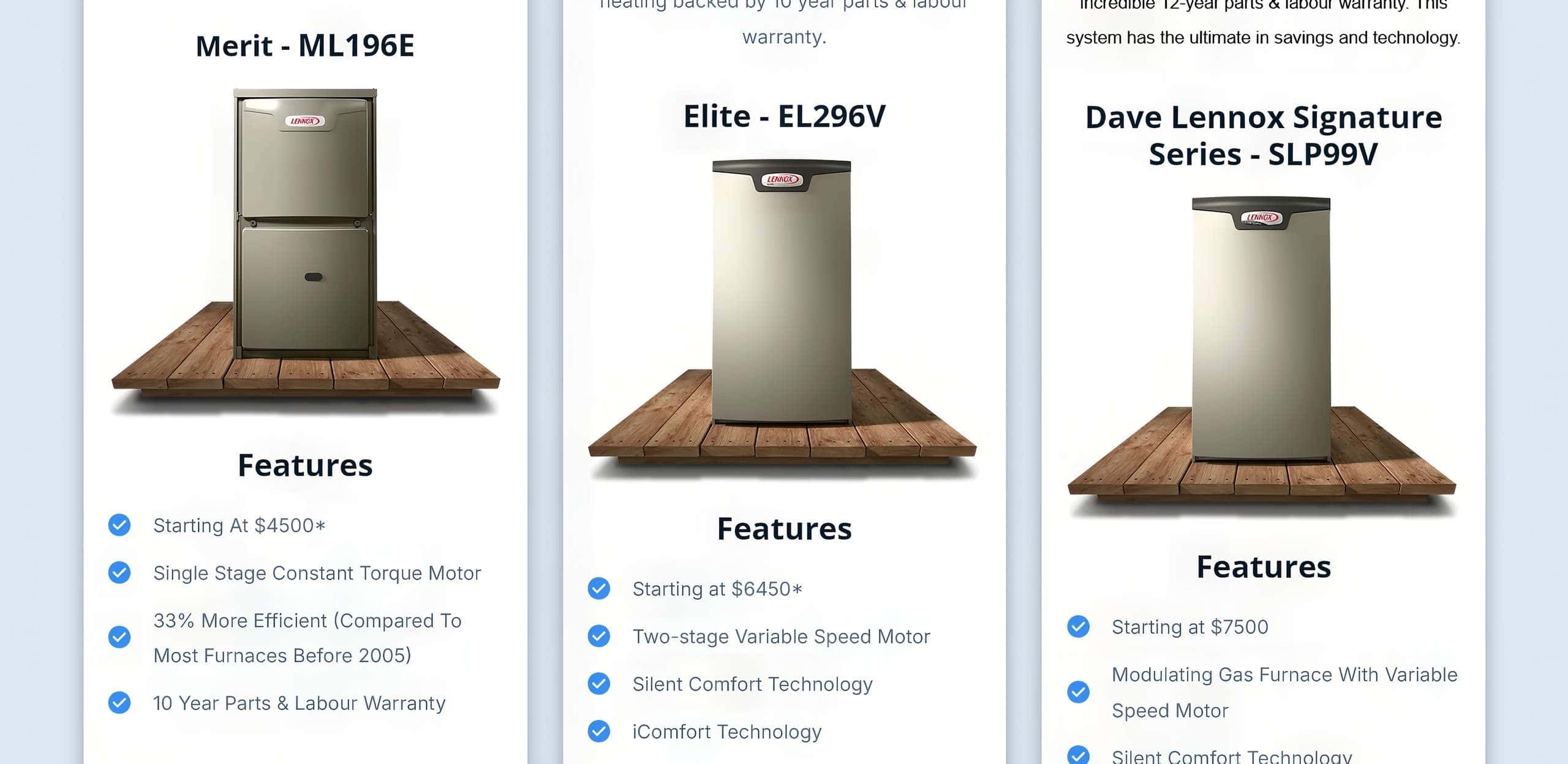
Images should be compressed to load quickly and be descriptively named, preferably using keywords in the image’s alt text.
For instance, the alt text for the following image might be “professional-hvac-service-technician-performing-ac-maintenance-on-outdoor-ac-unit”.
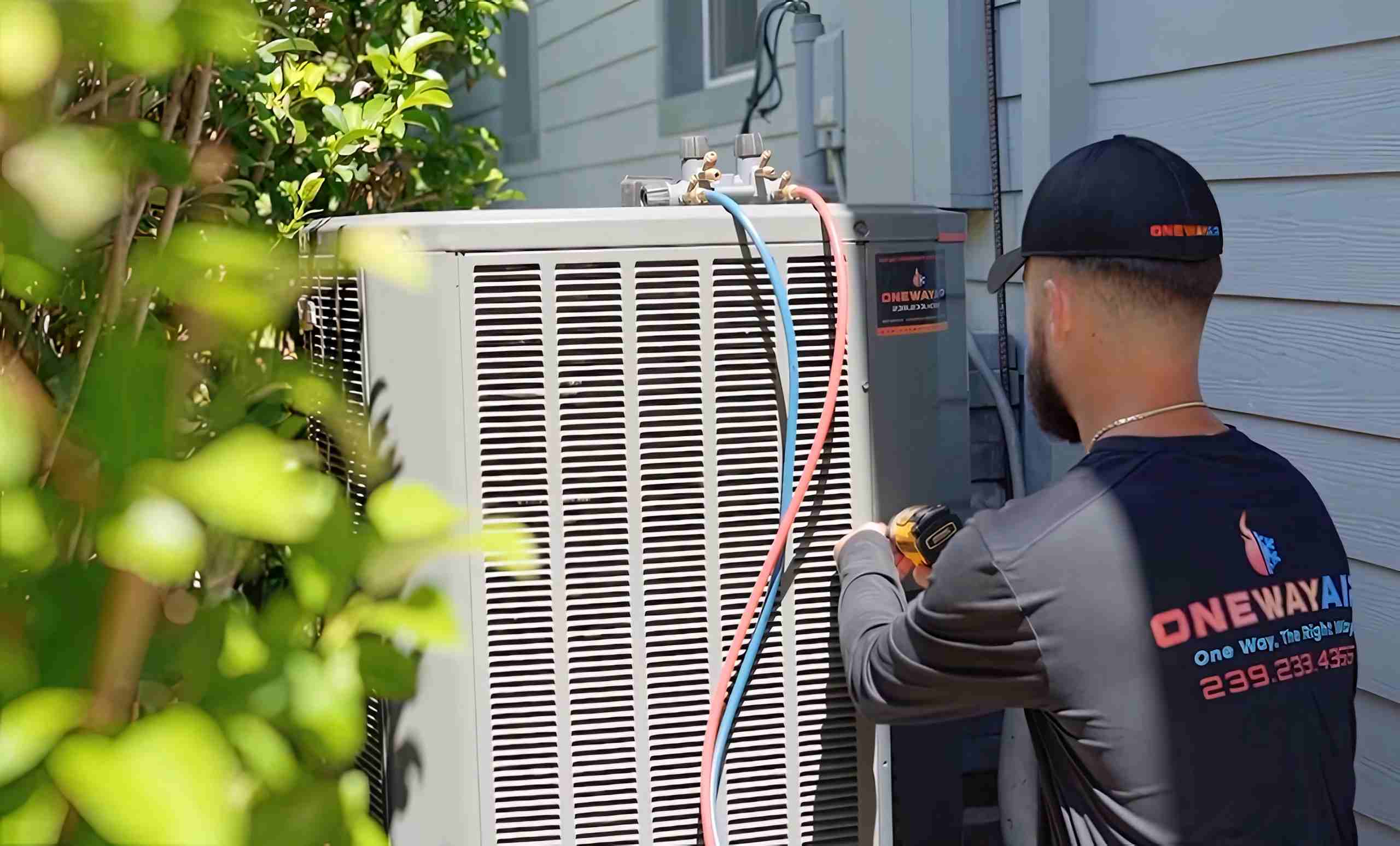
Schema Markup
It’s common SEO practice to put schema markup code on every page of your HVAC website to help the search engines understand your content.
This code helps your pages stand out on the SERPS with additional features besides the basic text, including:
If you search for “AC repairs in Boston,” for instance, you will see this listing, with a star rating, review number, and logo, helping it to stand out:

Your web designer or HVAC marketing specialist should look after this for you but it’s good to be aware of as it’s an “easy win” for HVAC companies.
Local SEO for HVAC Companies
Dominating local search by engaging in best-practice local SEO should be the goal of HVAC companies, most of which rely on local customers to grow their businesses.
The first thing to note is that Google’s local search algorithm has a proximity factor that considers the distance between the searcher and the business. When anyone searches for “HVAC company near me” or “AC repairs in [city],” for instance, Google shows three local businesses at the top of the page.
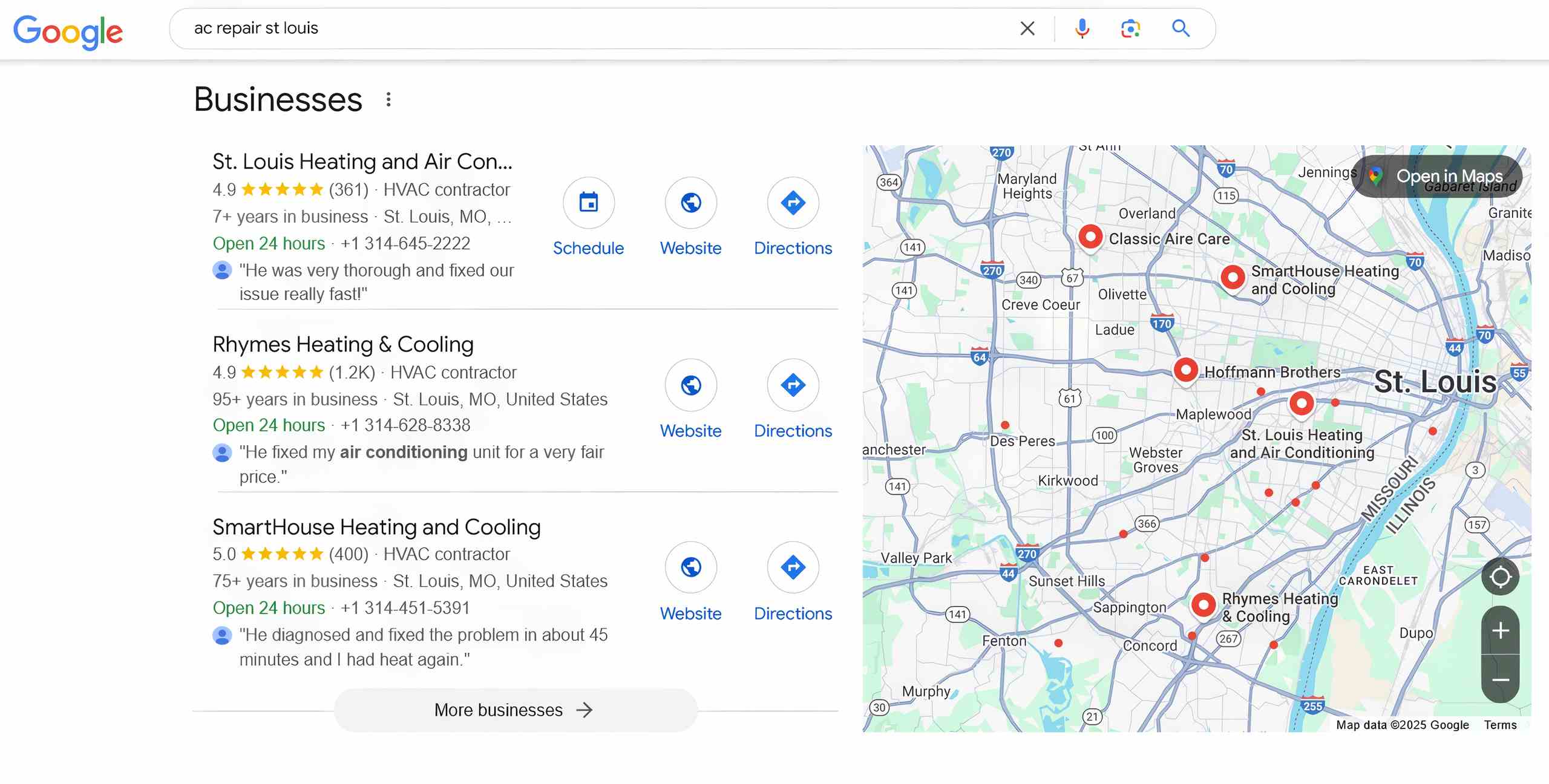
There are several aspects to conquering local SEO so that you show up in the relevant searches and attract a steady flow of hungry leads to your HVAC business:
The Google Three-Pack
As you saw earlier, the Google Three-Pack dominates local search pages. You should be targeting a position as one of the three featured businesses there for the services you offer and the location you’re targeting.
Sometimes, there’s a sponsored ad (paid for) at the top of the pack, making it four businesses featured.
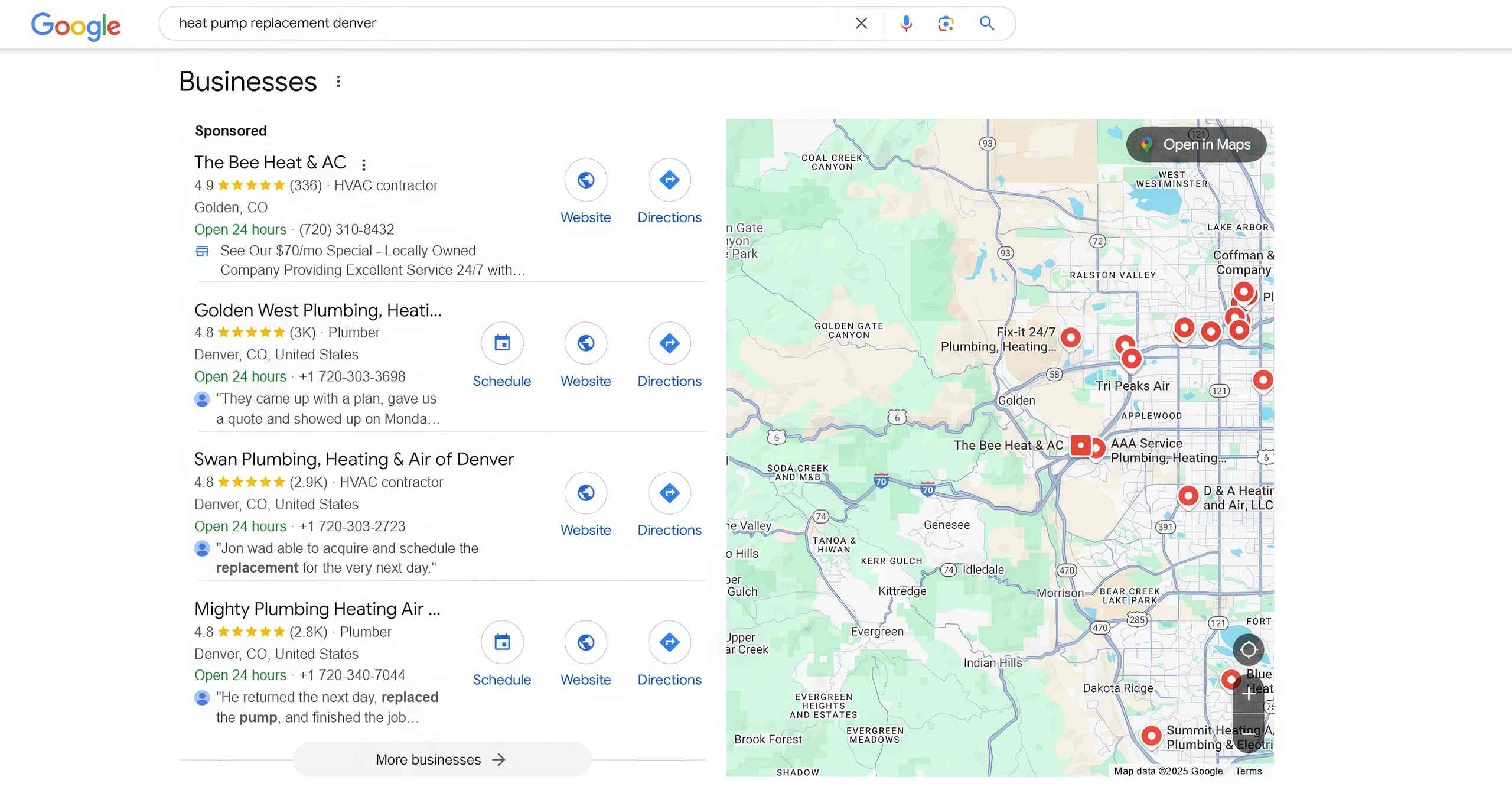
Google selects Three-Pack businesses based on four main factors:
- The completeness and optimization of their Google Business Profile
- The distance between the searcher and the business
- The relevance of the business to the search query
- The credibility of the business
The business listing includes its name, address, phone number, star rating, and website URL. The following strategies will increase your chances of appearing in the Three-Pack…
Optimize Your Google Business Profile
Assuming you have already claimed and verified your Google Business Profile, you should immediately optimize it if you haven’t done so already:
Mechanical Contractor, Air Conditioning Repair Service, etc.
Here’s a good example of a complete profile:

Find out how to optimize a Google Business Profile in this short video.
Actively Gather Reviews
Almost three-quarters of people check at least two review sites before making decisions. So, encouraging customers to leave reviews and responding to them is good practice for any business—and HVAC companies are no exception.
Reviews develop credibility, trust, and social proof with potential customers and are also an important local SEO factor that can help boost rankings and increase visibility online.
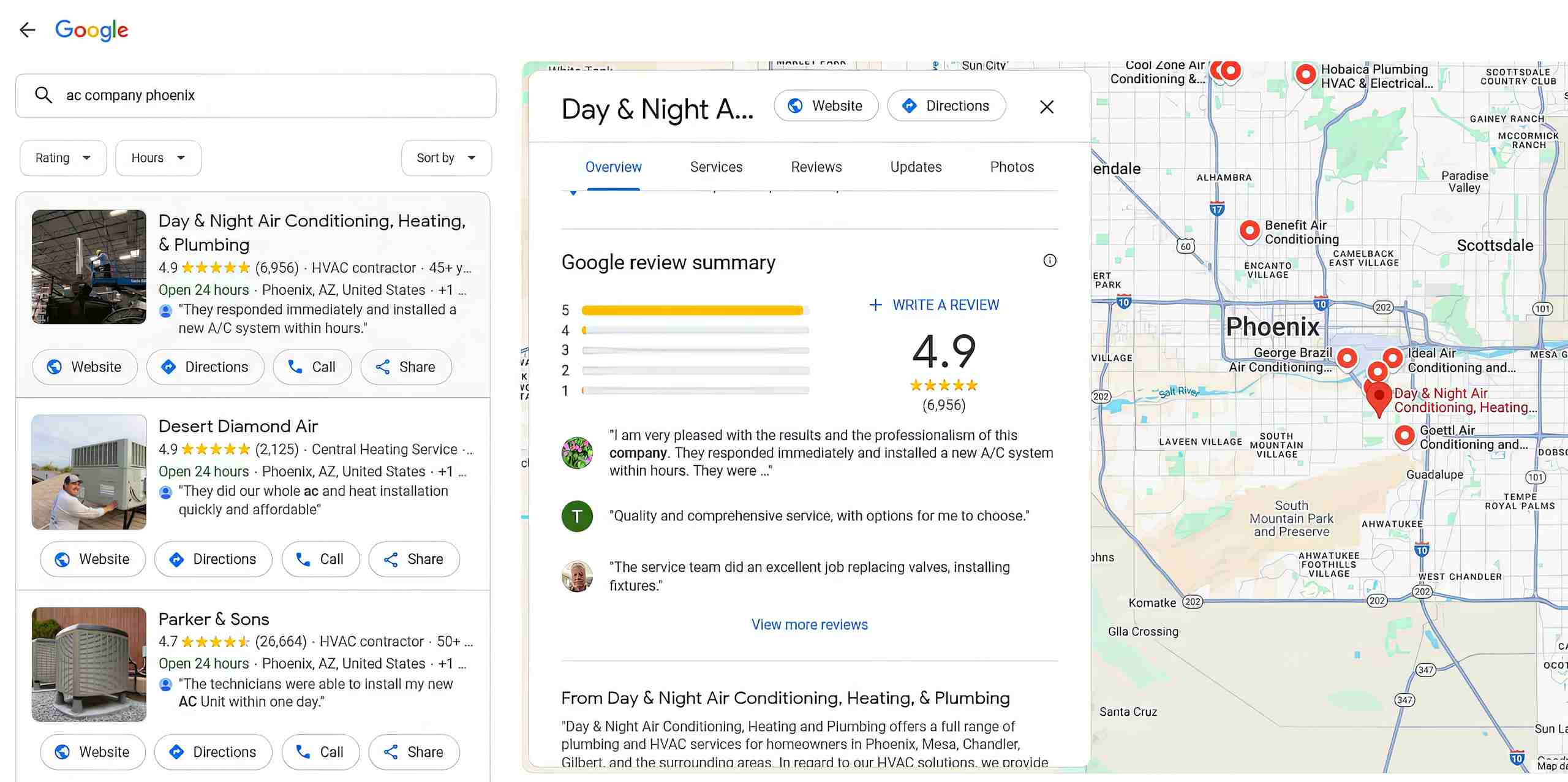
Managing your reputation online—where bad news travels fast—makes good sense anyway. Provide good service and make it easy to leave good reviews; it’s a no-brainer!
Consider setting up a dedicated page to make it easy to leave reviews of your business and, when jobs are complete, direct your customers there via a QR code.
Find out how reviews can help an HVAC business in this short video.
Gather Citations in Directories
Listing your business in HVAC directories, such as Angi, Porch, and HomeAdvisor, as well as Yelp, Yellow Pages, etc., also aids local SEO. Mentions of your business are called “citations” and even without a backlink to your website, they can raise credibility with Google and, thereby, boost local SEO rankings.
Again, a consistent and up-to-date business name, address, and phone number (NAP) and a consistent website URL, opening hours, etc., help cement your business’s online credibility.
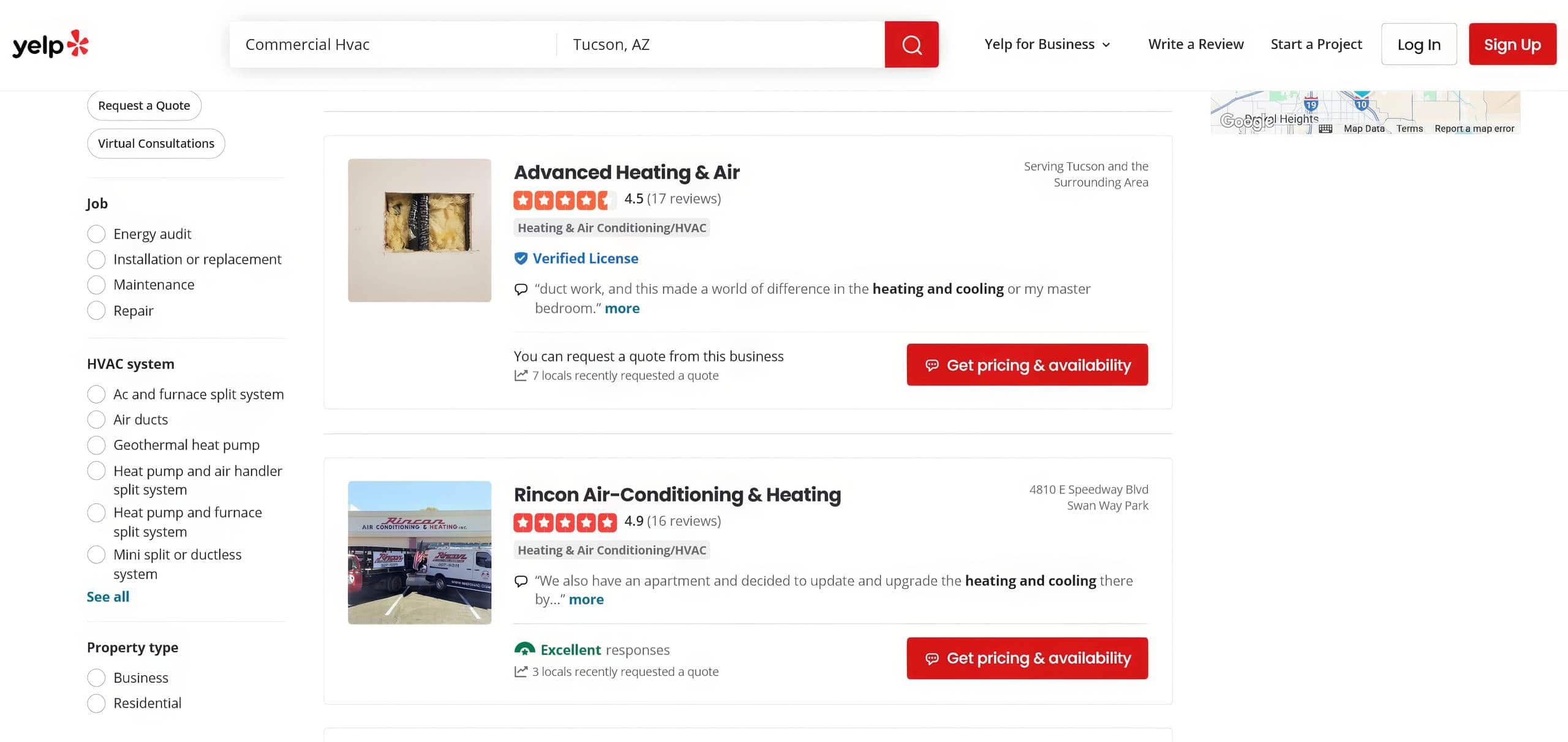
You can find a list of directories where HVAC companies might consider listing here.
Create Pages Targeting Specific Service Areas
Once you’ve developed your website and it starts to become established, a good way to expand the site is to add location pages for all service areas you target.
Here’s another example of a specific location page for an HVAC company in North Carolina:
The location-based keywords are useful for generating specific leads from that area.
Technical SEO
Don’t be put off by the term “technical SEO.” Your SEO specialist and web designer should look after any technical tasks for you.
Technical SEO is the process of creating a user-friendly, secure, navigable architecture and code for the website—both for users to follow and for Google to index.

First, understanding the “health issues” that must be addressed with an HVAC website may require an SEO audit from a professional. The most important elements are generally the following:
INSERT VIDEO ON TECHNICAL SEO?
Another aspect of technical SEO is structured data markup with HVAC-related schema, which has already been covered in the on-page SEO section.
Optimizing for Speed
The usability of a website starts with speed. Nobody, including your customers, will wait long if pages don’t load snappily. Google Consumer Insights estimates that if a page takes longer than three seconds to load, 53 percent of visitors will abandon it.
Google also uses page load speed as a ranking factor and will penalize slow sites. So, it’s important to check page load speeds here.
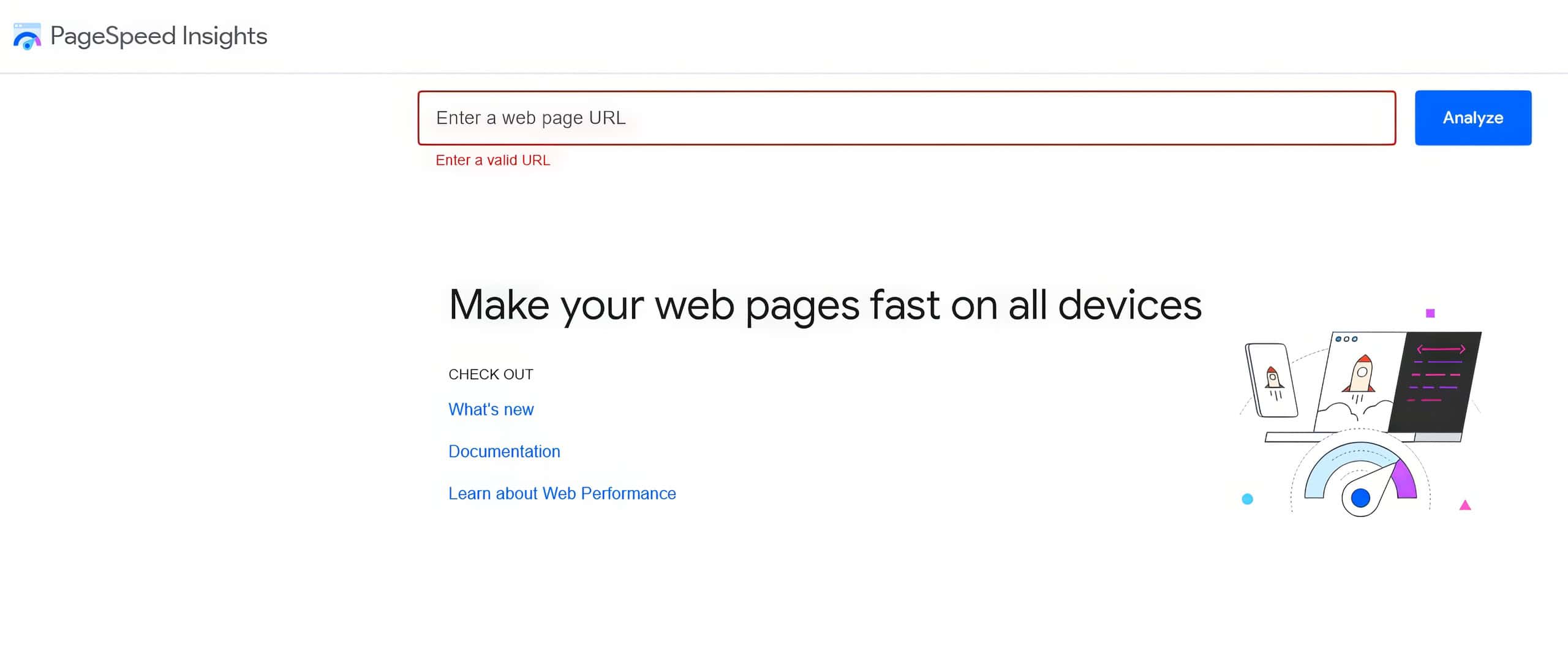
If there are any slow-loading pages, try the following:
Optimizing the Site Architecture
An optimal site architecture allows search engines to navigate and index pages easily—otherwise, search performance may be impacted.
Your web developer should focus on creating a clear hierarchy of pages with categories and subcategories. An XML sitemap and robots.txt file should also be included.
Optimizing for Mobile
Almost two-thirds of online searches are from mobile devices—and your customers are more likely to find out about (and book) your services from smartphones, tablets., etc., than from desktops.
Building your website with a mobile-first design makes sense. This means:
Mobile-friendliness is important to Google and there are multiple ools you can use to check the performance of websites, imcluding the Mobile-Friendly Test from SmallSEOTools:
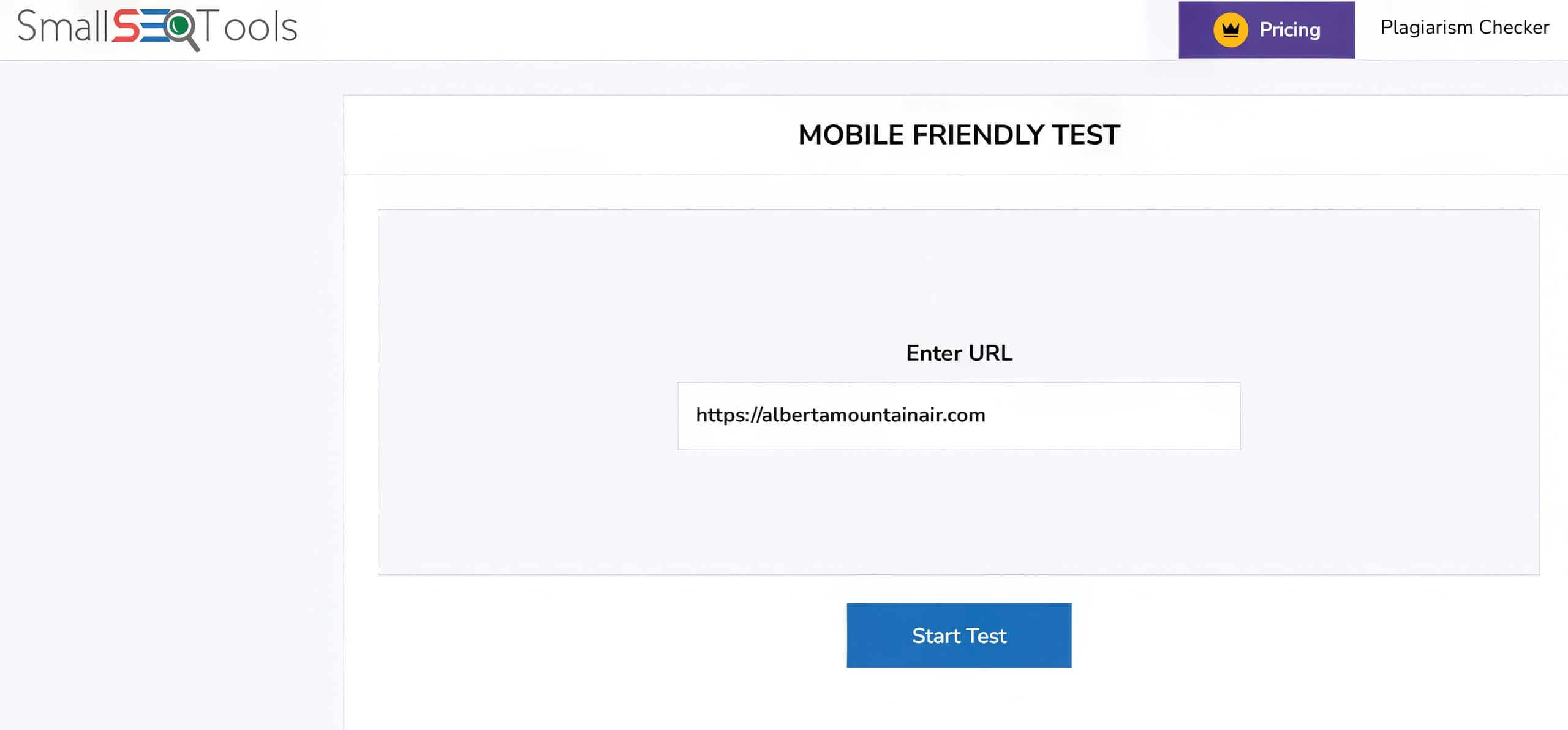
Optimizing Security
Website security is another aspect of technical SEO for HVAC companies.
Creating a site using the HTTPS protocol means data between your web server and browser is transferred with secure encryption. This can improve website rankings and customer trust, especially if users provide sensitive information online, such as addresses.
Security can be further enhanced with an SSL certificate—essential if you accept credit card or other payments through your website like this HVAC company:
Optimizing Links
Optimizing links on your website is a two-fold undertaking distinct from link-building, which is dealt with below.
- Check for and fix any broken links, as these could damage your rankings. Use Ahrefs or Semrush tools to help you identify broken links (these SEO audit tools will also highlight other issues like keyword stuffing or thin or duplicate content).
- Implement a logical internal linking strategy that ties your website together and allows users to navigate easily from page to page.
Link-Building for HVAC Companies
The number and quality of backlinks on your website make a difference in almost every aspect of SEO performance for HVAC companies. It remains one of the Top 8 Google ranking factors even in 2025.
Link-building actively seeks backlinks from credible, relevant, and authoritative websites. This increases the authority of your HVAC website because Google rewards sites referenced by established peers, boosting rankings as trust levels grow.
What Types of Links Should HVAC Companies Target?
Ideally, your website gets backlinks from established educational organizations, media outlets, and other “authority” sites—but that’s very tough for HVAC companies.
More realistic targets for backlinks for HVAC companies include:
One or two links from high-authority sites are often better for SEO than multiple low-authority links. Low-quality links can damage your authority, reputation, and SEO efforts.
It’s best to avoid:
You can use Semrush’s Backlink Audit tool to check for “toxic” backlinks.
Ideally, the quality of the content on your HVAC website attracts plentiful backlinks from other sites that value your information. However, actively seeking backlinks is also a key SEO strategy for HVAC companies. The following are a few proven link-building strategies to bear in mind…
Target the Sites That Your Competitors Get Backlinks from
You can identify the sites that link to your competitors using this Backlink Analytics tool. This will tell you:
Guest Post On High-Quality Related Sites
We deal with content marketing below but one “side-strategy” for content is to write blog posts and articles for other sites in return for a backlink.
Websites that might value content from HVAC companies include home improvement sites/blogs and real estate sites/blogs. These posts should be relevant to the site’s users and provide valuable, informative content. Target high-quality, credible sites that will provide a high-value backlink.
Identify Unlinked Mentions
We covered unlinked mentions of your business online (citations) above. Identifying these mentions may uncover opportunities to add a backlink from authority sites if permitted by the site’s link policy.
Many tools can help you identify relevant unlinked brand mentions, including Moz Pro.
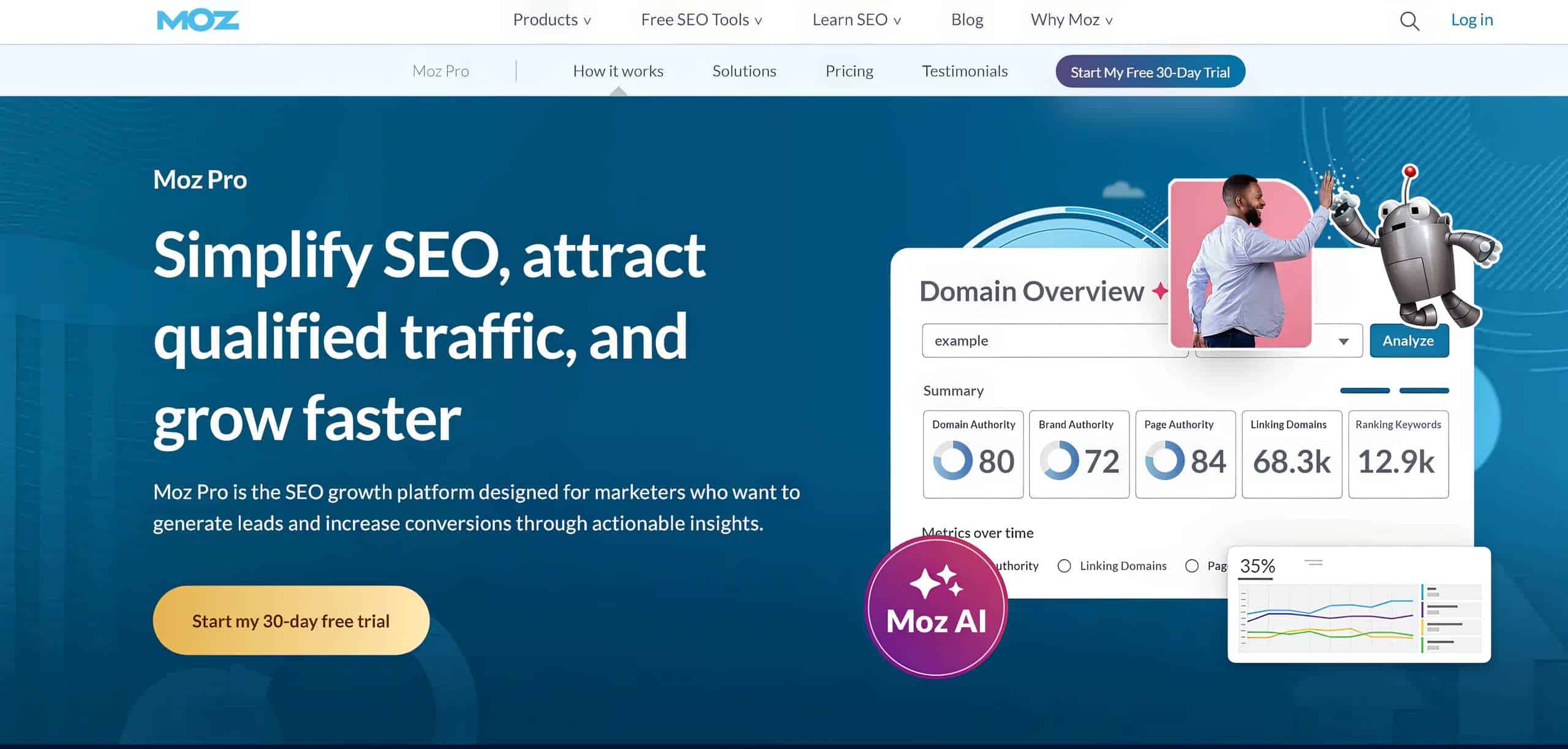
Content Marketing
Content marketing is one of the final pieces of the SEO jigsaw for steadily boosting search rankings for HVAC businesses.
Like almost all SEO activities, content marketing takes both strategy and time. It is not a quick fix and it can take several months to see results.
But it works.
The best types of HVAC content for SEO are typically written to be informative for the audience AND optimized for search. They could include:
Content marketing is multi-faceted but has multiple benefits. Here are some strategies that form the foundation of a successful HVAC content marketing strategy…
Develop High-Quality Content That Comprehensively Answers the Questions of Your Target Audience
Start by creating a blog with content that answers the main questions of your target audience.
Homeowners whose furnace is not blowing warm air might simply need to change the air filter. They probably don’t need an HVAC company for this. Providing information about how to change an air filter demonstrates your expertise and gets your HVAC business on their radar so that when they need the services of an HVAC company, they call you rather than a competitor.
You’ve already identified the main search terms to target during keyword research but you can go very deep with content using longtail keywords. For HVAC companies, these might be:
By focusing on FAQs, you naturally incorporate keyword phrases into your content while attracting eyeballs from your target audience—both should boost search performance.
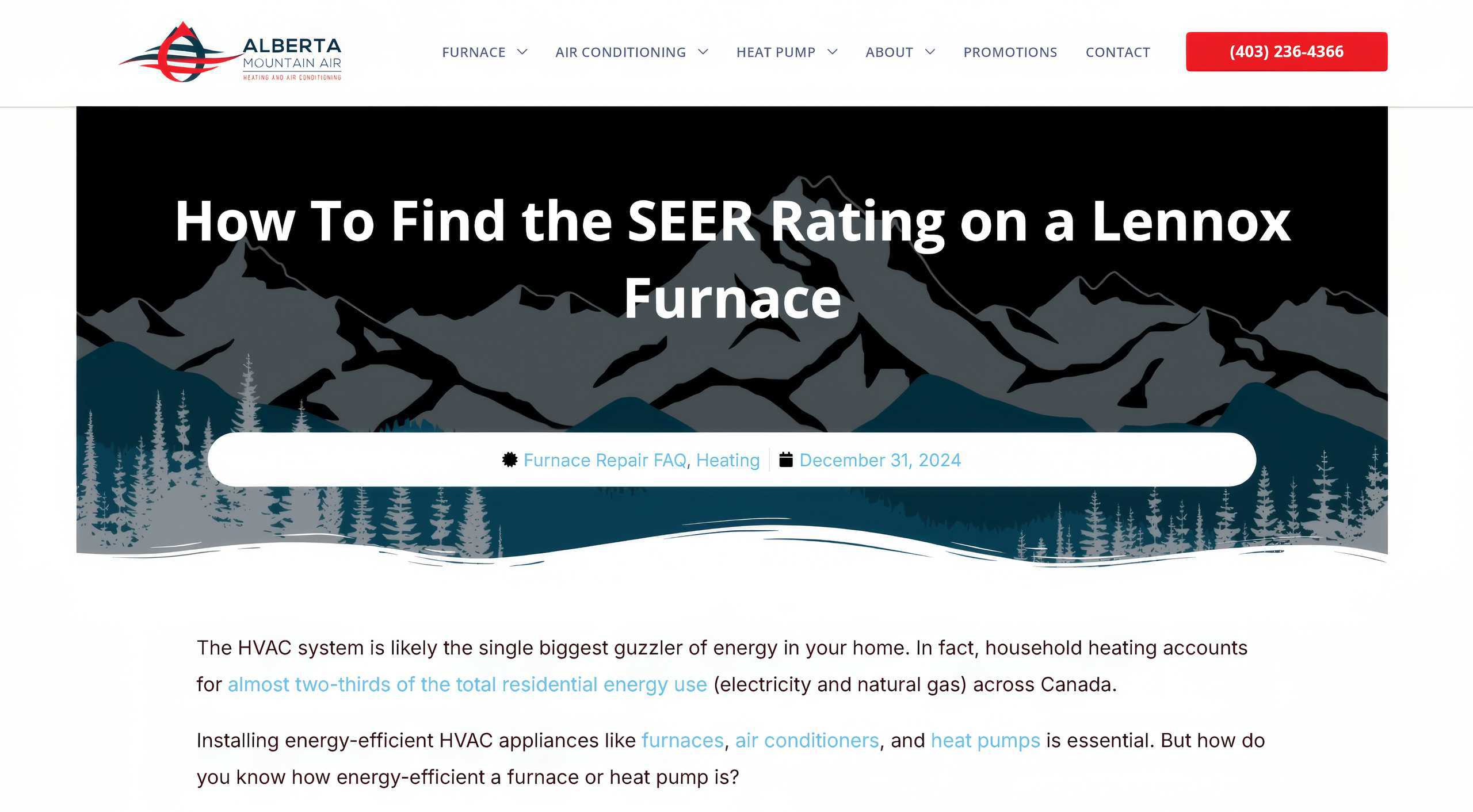
High-quality content is also clickable and sharable, which should help your HVAC website’s backlink profile.
Make Your Content SEO-Friendly
Some tips for making your content SEO-friendly:
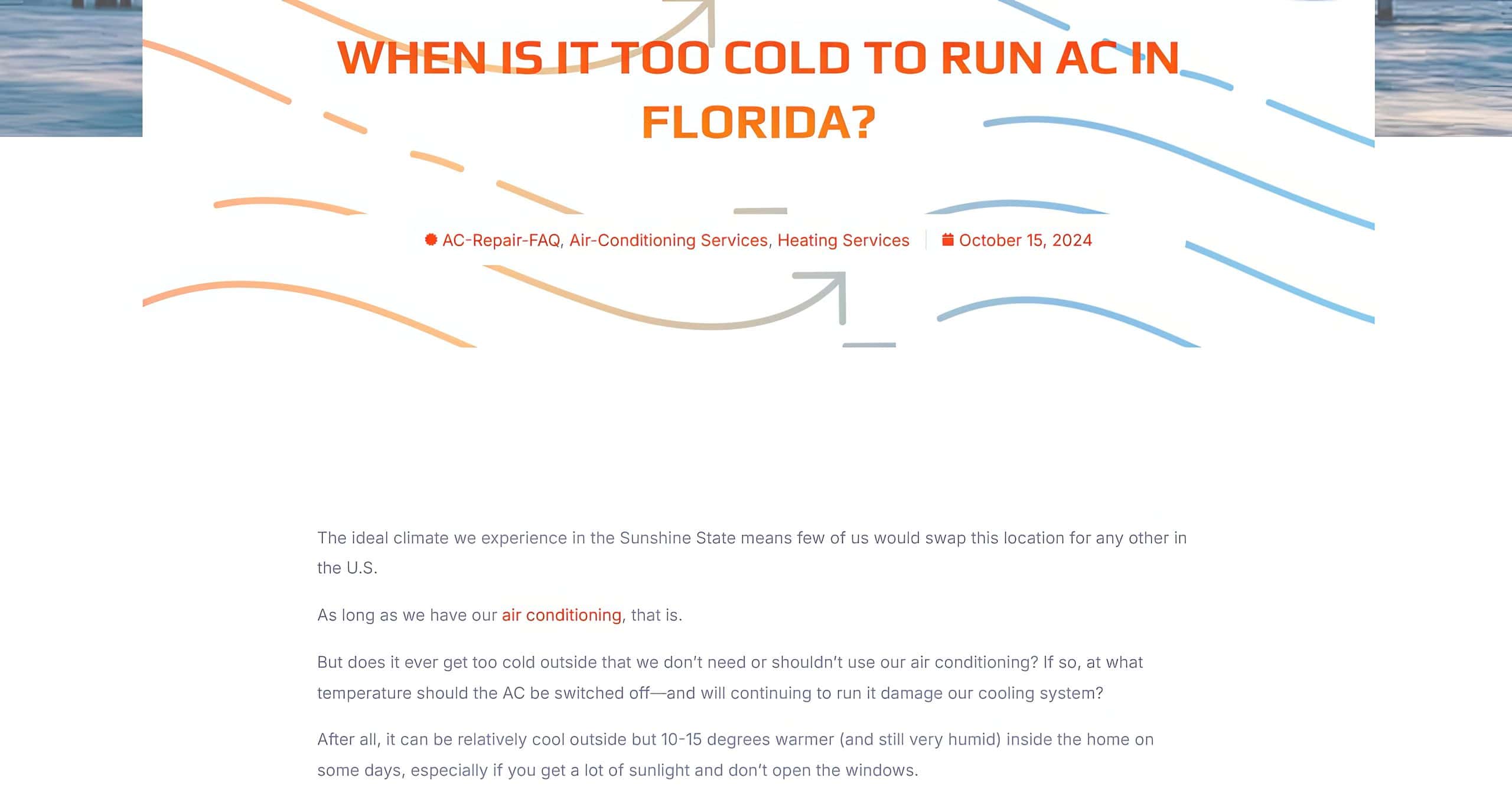
Include Related Keyword Phrases
Well-written content on HVAC subjects should naturally include related terms to the primary and secondary keywords it targets. These are known as “semantic keywords,” and they help Google understand the posts’ context.
If you’re unsure, plenty of tools can help identify these terms. Most obviously, Google’s “People Also Ask…” section includes searched-for questions on the topic you’re investigating—like this example for “What refrigerant should I use in my home AC?”:
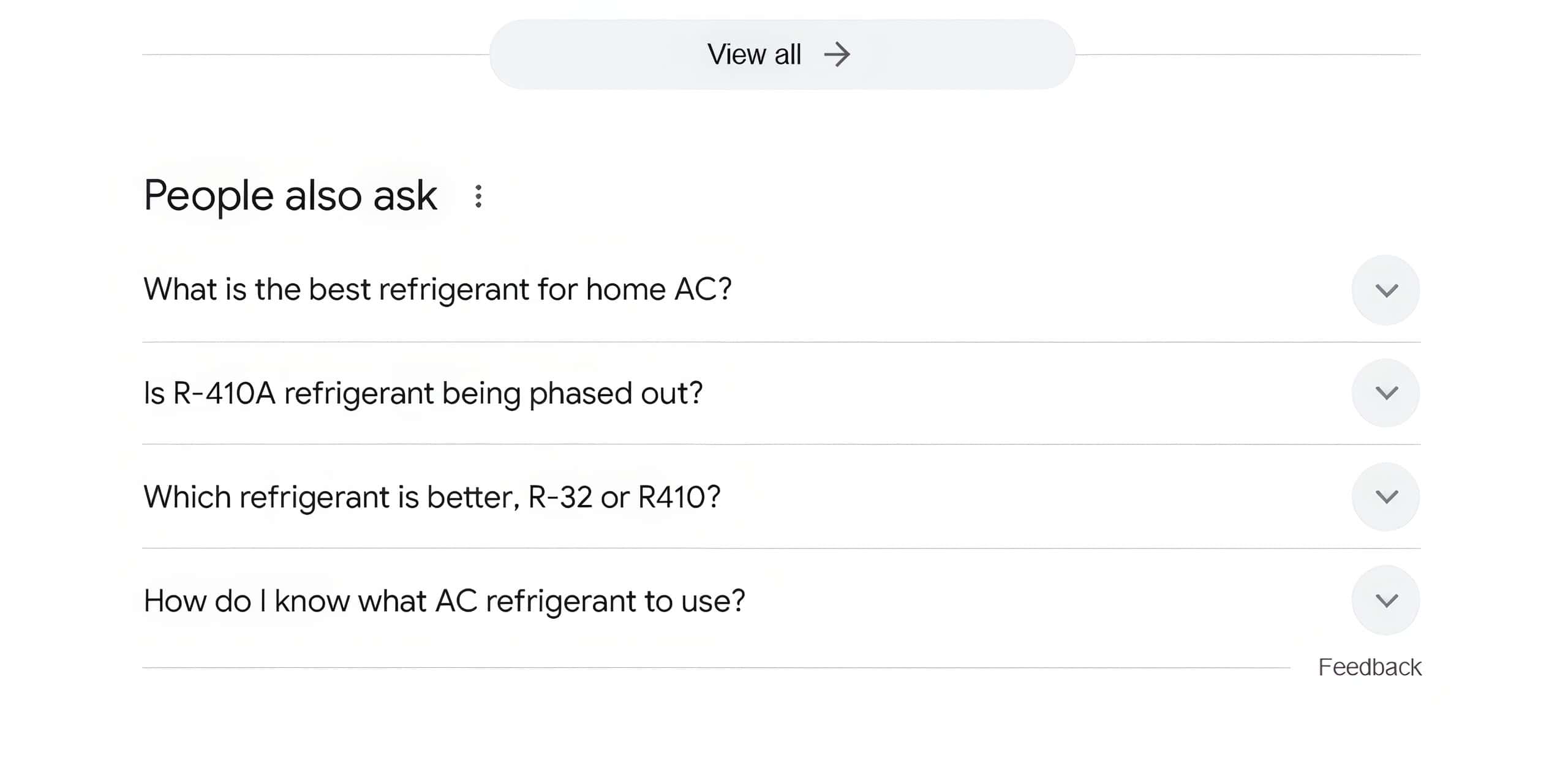
Build Out Your Location and Service Pages
Ideally, create HVAC service pages for each of your services, breaking content down into separate pages, i.e., Furnace installation, furnace maintenance, furnace repairs, and emergency furnace repairs should all be separate pages.
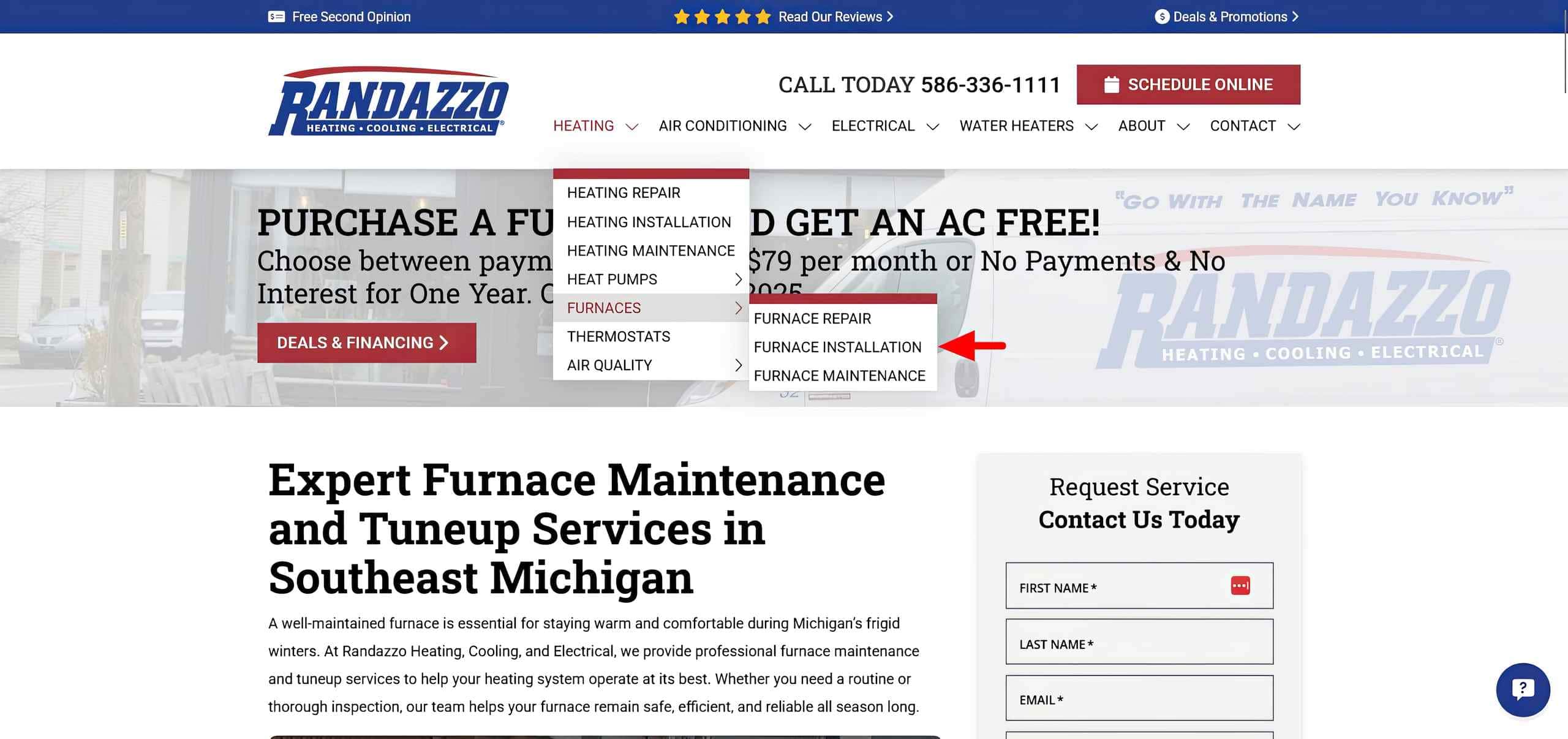
As mentioned previously, you should also get “granular” with your service areas, with pages targeting specific locations, which will improve local SEO.
Develop High-Quality Video Content
I’m speaking from personal experience when I say that video content can help your business rank and generate leads—and, in my opinion, video will continue to become more influential with SEO. If it’s informational and high-quality, it’s highly sharable.
HVAC video content can include the following for starters:
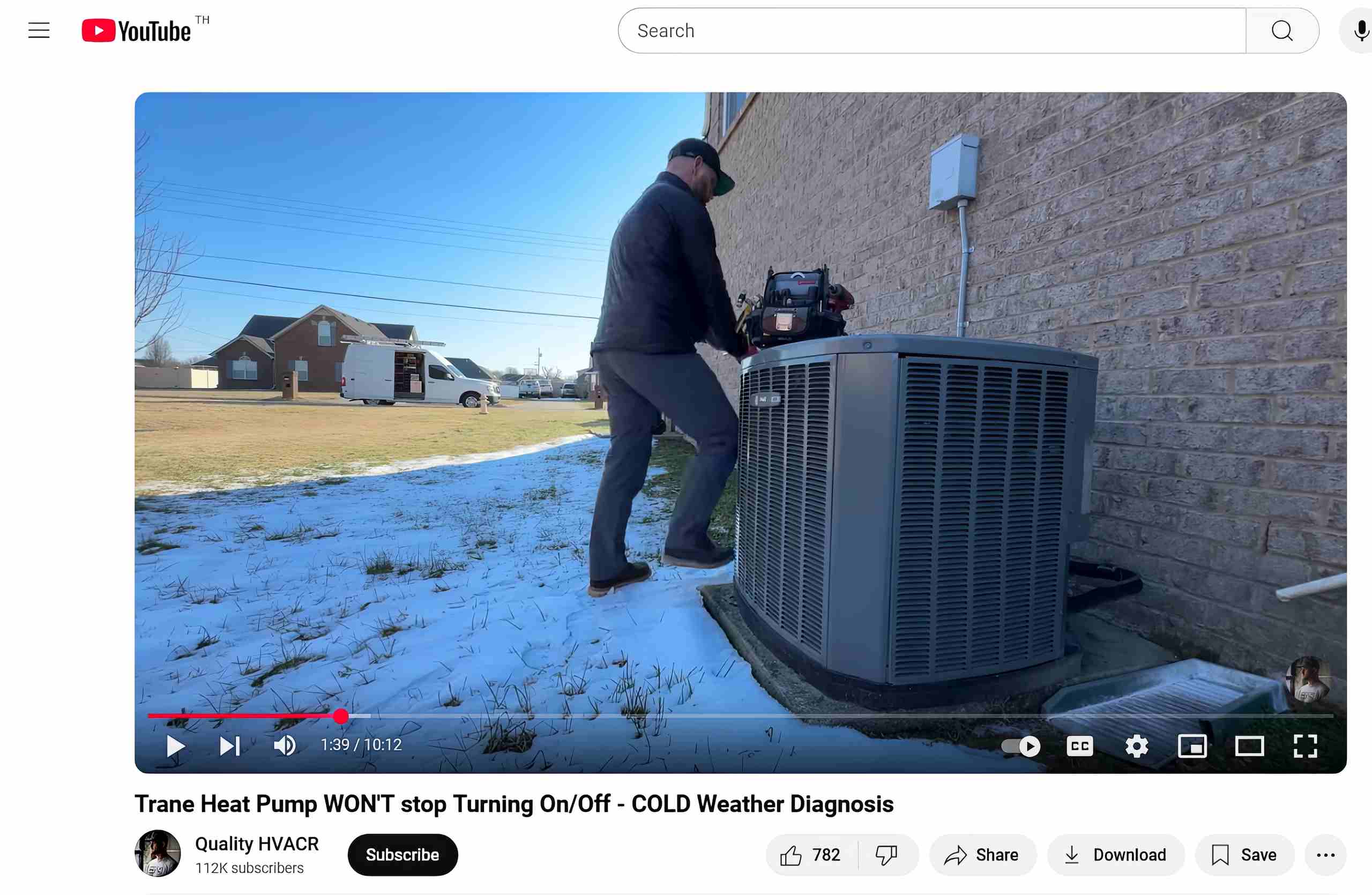
Common SEO Mistakes to Avoid for HVAC Companies
The most common mistakes we see from HVAC companies are:
By avoiding these mistakes and following the SEO tips above, HVAC companies can steadily grow their online presence and reputation—generating consistent, high-quality leads without spending a fortune on ads.
SEO takes a concerted effort over many months and years to truly crack it but the rewards are more than worth it if you’re looking to grow…

FAQs
For a fully tailored and professionally managed HVAC marketing strategy, including HVAC SEO services, contact us here to set up an introductory call.

Relevant Posts
Have a look at our related blogs.
/
Want More High Quality Leads?
It all starts with a quick and easy 30-minute call. We will help answer all of your questions and if we are a great fit after our call, we will schedule a more in-depth video call to help build out a strategy for your company.
It is that easy!



